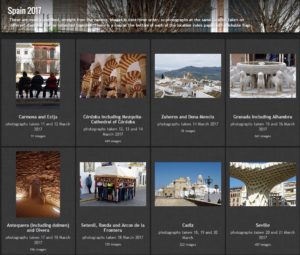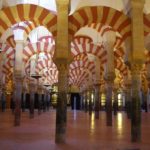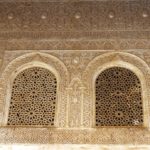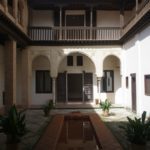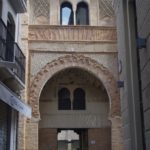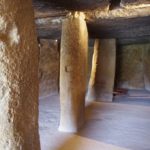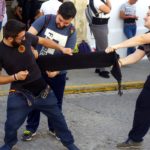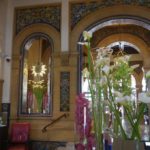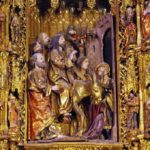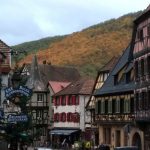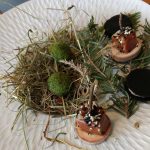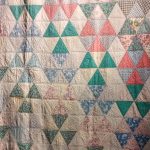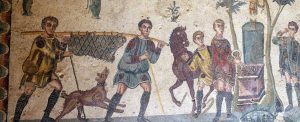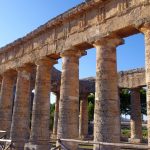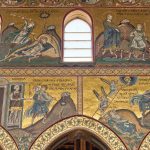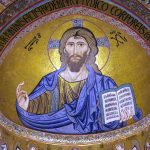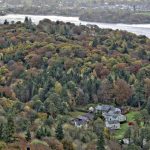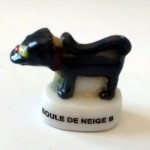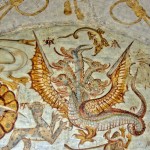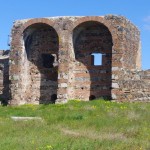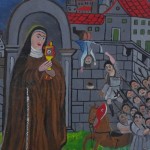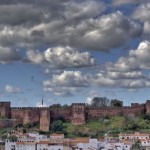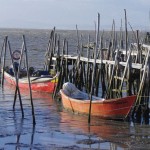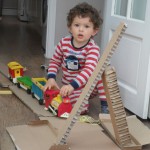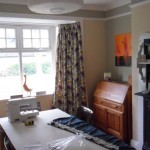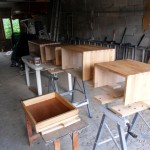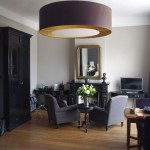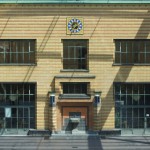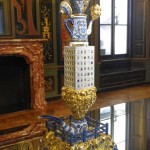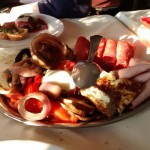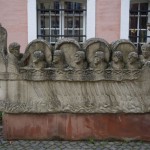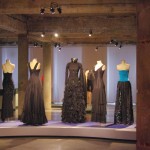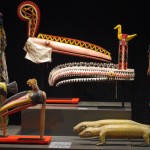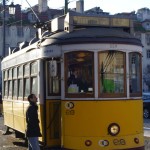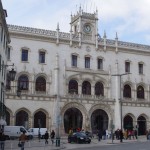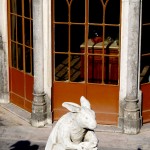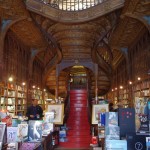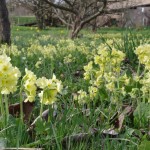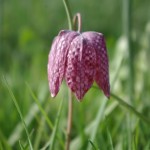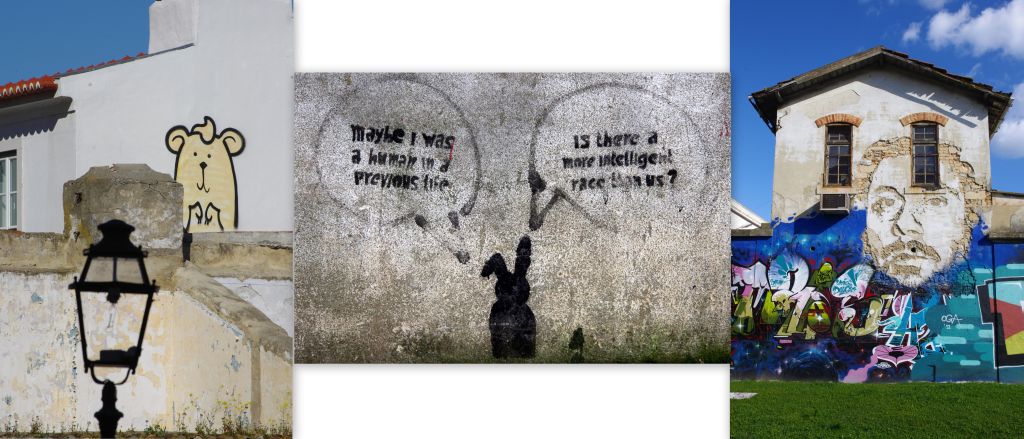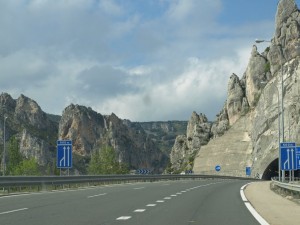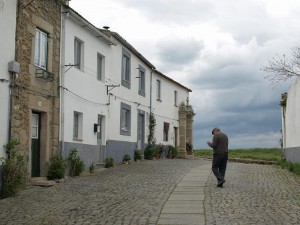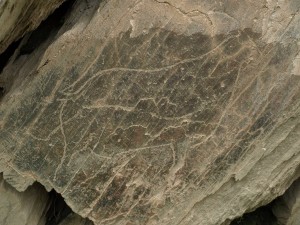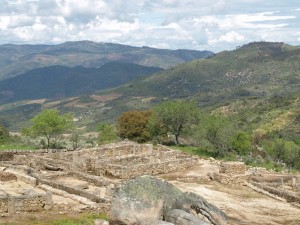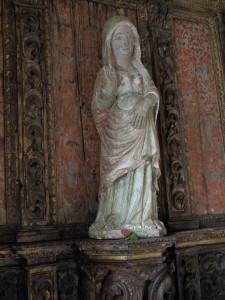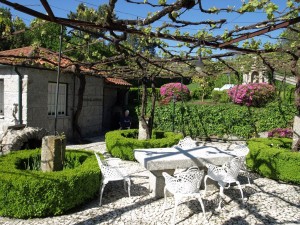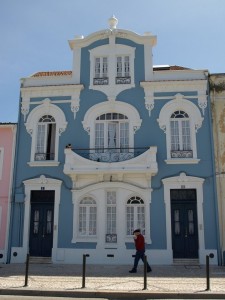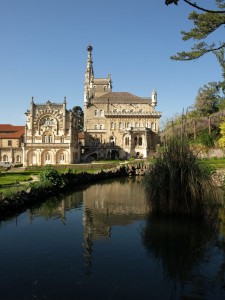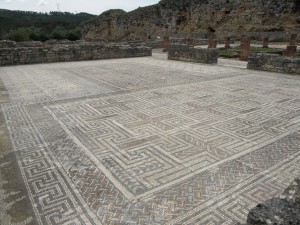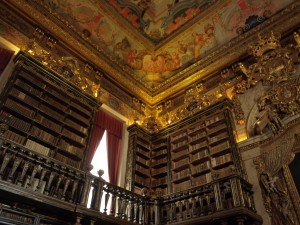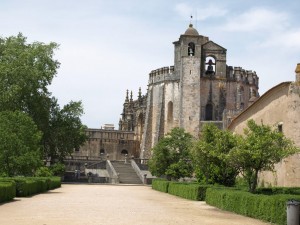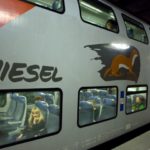An unedited set of the 450+ photographs I took 30 May-2 June
Click on this image to go to the photographs:
Category Archives: Travel
Pagans, Christians and Moors: meandering in the Vosges, the Fens and Andalusia, January – March 2017
To download a printable PDF version (no pictures)
click on this link E2E2017no1.pdf (eight A4 pages)
The links in the text will take you to photographs of the location
We visited more than is mentioned in the text
If you wish to see more photographs, click on the image below for the full set
At the beginning of January we folded up our pagan Letchworth Christmas tree, wrapped the baubles in tissue, and regretfully discarded the holly, ivy and yellow jasmine (why didn’t that jasmine didn’t get into the carol?) in the conservatory and set sail for Entre-deux-Eaux. With snow forecast we stopped for a night en route in Reims; it was bitterly cold as we walked towards the dimly-lit cathedral. A few nights later temperatures were down to -18°C at night and continued to be very cold for a couple of weeks.
During January we usually relish the epiphany feasting in and around Entre-deux-Eaux. This year Helen had her gall bladder extracted on 13th, as, sadly, it had restricted her eating over Christmas and New Year. John nobly went alone to Mayor Duhaut’s Voeux (inaudible speech, champagne and nibbles) after visiting hours, and we did both go down to the oldies’ gathering on 17th after they had finished eating a very fatty (and satisfying, we gather) protracted lunch of pork, sausages, cheese and plentiful booze, and we were plied with galette des rois and champagne. In fact we did more short walks than feasts, as the snow which started during the night of Helen’s operation, was enticing in the sunny afternoons.
So, at the beginning of February we felt it was high time we ventured out to a restaurant (and no newsletter would be complete without a restaurant trip!) It is a long time since we have been to our nearby Book Village in Fontenay-la-Joute, so when John read about a restaurant, L’Imprimerie, in the former printer’s we decided to go there. Only one table was occupied when we arrived, which didn’t augur well, but we chose a table close to the blazing fire and settled down to await the menu. The waiter seemed half asleep, but produced two torn up children’s books (shock, horror for Helen) with inserts giving the prices of three menus, but no details of the food on each. We managed to extract information about the menu of the day, but he kept insisting that the other menus were a surprise, as were the accompanying wines. Eventually he checked with the chef, and on hearing that chef was proposing to include coquilles St Jacques and then pigeon and pork, Helen hastily settled for the safer menu of the day, but John chose a more adventurous one. To our surprise, John’s surprises all turned out to be beautifully and imaginatively presented, with lots of little pre, inter and post delicacies. We’d happily return with anyone who doesn’t mind gambling on what they eat!
By mid February we were back in Letchworth for half-term. We returned to the Higgins Museum in Bedford, taking Jacob as it is such a child friendly museum, and spent quite a bit of time talking about fossils with him. Another day we discovered that Stevenage is not all new town, but has an attractive old town with a wide high street similar to many old market towns. On a gloomy day we had an unsatisfactory attempt to reach Ely through the grey fens; the obstacle was nothing to do with resistance from Hereward the Wake, but due to a serious road accident which caused jams blocking all roads in.
The fenland theme continued when we were in London and went to see the Mildenhall Trove at the British Museum (we had previously driven through Mildenhall, but not explored); the Roman silver tableware was stunning, and we were interested to see on their map of finds how well the fens had preserved many other treasures. After that we couldn’t resist mingling with the eager school children and their clip boards to see the Sutton Hoo burial display. In the afternoon we saw the revival of Stoppard’s Travesties (we’d seen the 1974 original), which was good, and ate at Moro in Exmouth Market, which was disappointing. Another trip to London saw us at an unexpected venue, the London Corinthian Sailing Club, to celebrate in style John’s school-friend Alan’s 70th birthday. John’s sister Ann and brother-in-law Derek had just moved from Essex across the Thames to Tenterden in Kent and we spent our last two days with them, enjoying lunch in a good country restaurant (The Curlew outside Bodiam) and a walled garden centre in Hawkhurst (the hellebore which we bought there is flourishing back in E2E, a reminder of the time that Helen’s mother spent as Headmistress of Lillesden School in Hawkhurst, which is now apparently converted into smart apartments after closing and featuring in Doctor Who episodes). The channel crossing was rolling next day and we crossed northern France through lashing rain, blinding spray and high winds.
Back in E2E the dull wet weather of early March soon felt oppressive, with few diversions other than the free audition tests offered by the hospital (expected results: Helen OK for her age, John not). This time last year we had been happily meandering round south-east Portugal, intending to cross into Spain and explore Andalusia, but found so much to see we did not cross the border. Almost as soon as we thought of our uncompleted trip, John had booked flights from Basel to Seville and back and a hired car. We don’t usually plan our hotels far ahead, but in the miserable weather we enjoyed reading guidebooks and hotel reviews, and ended up booking hotels for every night, some of which were to add greatly to our appreciation of the region. As we drove to Basel on Saturday 11th, we realised that the permitted season for certain Vosgian river fish must have opened, as there were damp fishermen on every bridge.
Seville airport was hot when we arrived, and we were glad not to be heading towards the narrow streets of the city in our hired car whose air-conditioning didn’t seem to be working efficiently. Instead we sped along the A4 in the opposite direction across the plain towards Cordoba until we could see on our right that night’s destination, the small fortified hill town of Carmona. Turning off towards it, the small road got steeper, goats scattered in front of us, we passed a ruined chapel and suddenly a huge old gateway, the Puerta de Cordoba, engulfed us and our sat nav was directing us through narrow streets past joyous family meals in a street bar, emerging onto the escarpment with breathtaking views and our hotel, the Alcazar de la Reina. Helen is easily impressed and the two sinks in the spacious cool cream bathroom, added to the friendly welcome, the carpeted entrance, traditional heavy furniture and shady courtyard and pool appealed to her. Given how every street space in Spain seemed to be taken up with parked cars, we were glad we’d opted to book hotels with their own parking.
On the main San Fernando square with its huge palm trees with tiny thatched tops, children were playing, the little girls all in beautiful frocks, with big bows in their hair and satin pumps on their feet. Were they dressed up for a special Saint’s day? The bar and café tables round the edge of the square were full of families and friends drinking and eating, but a space was found outside the Bar Goya and we ordered cold drinks, a squid salad and pigs kidneys in sherry and enjoyed the feeling of having arrived. Revived, we wandered downhill through the narrow streets and spectacular double-entranced Puerta de Sevilla into the “new” (or later) town, ending up at the Roman necropolis. Only part of it was open (half an hour before closing time), but it was interesting to peer into the large holes and linked cave system with its statue of an elephant. In the bar/restaurant where we ate later, braided boys with drums joined their friends (what had we missed?), and outside a soutaned cleric fretted over his loose wing mirror.
Next day, further along the A4 to Cordoba, we stopped in Ecija and followed our noses and the glimpses of elaborate church towers into the old town. The highlight was coming across the Palacio Benameji and sticking our noses through the gateway. In an inner courtyard children, in silent concentration, were learning to make Roman amphora and oil lamps which were put to dry in the sun, and up the sweeping staircase we found a surprising array of fine Roman mosaics is displayed on the walls. Downstairs were interestingly carved prehistoric stones. An unsung provincial museum! And we’d nearly ignored it in favour of coffee (which we subsequently enjoyed just outside the palace walls).
Cordoba’s Archaeological Museum’s mosaics were disappointing in comparison, as they are still in the unsafe older part where they can’t be seen; but the excavated Roman amphitheatre in the basement of the new building was fascinating and well explained. It was probably the return of rain and the bog-standard 4* but quite pricey hotel (which couldn’t change a dead light bulb for 18 hours) which coloured our impressions of Cordoba. All the pictures of the Mezquita which you see emphasize the rows and rows of columns and the light, spacious feel of the huge old place of worship. They don’t prepare you for the fact that your view as you walk in is blocked by the elaborate cathedral which was later constructed in the centre of the mosque to reclaim the space, while the Mezquita walls have ornate chapels on three sides which prevent light from entering.
It is only when you close your eyes to the obstacles and walk round the cathedral towards the austerely decorated mihrab that you get more of a feel of the constantly extended forest of columns. Another jarring image of Cordoba was the rain-swept Roman bridge with coach loads of Chinese and Japanese tourists leaning into the wind, some with sinister-looking scarlet face masks like modern invaders.
Granada was such a contrast to wet Cordoba. The sun was shining to welcome us as we drove towards the top of the hill facing the Alhambra, following complicated instructions to the hotel avoiding the narrowest and steepest one-way streets of the old Moorish quarter. Our hotel (Santa Isabel la Real) was a delightful restoration of an old building, and we were graciously seated in the beautifully traditionally furnished sitting room with coffee and fresh lemonade while the paperwork was done (always surprisingly time-consuming) and our room was prepared (we were early), then the easiest way of accessing the Alhambra and the useful local buses were explained, and the housekeeper took us up to our room on the first floor, following the balcony round the inner courtyard. It was cool and shady with old beams, and a cool white bathroom.
A couple of hours later, we had walked round some of the grounds of the Alhambra, admired the views of the snow-capped Sierra Nevada, detoured into an exhibition of Mariano Fortuny’s 19C Andalusian sketches and paintings which felt just right for the occasion, and also the archaeological museum, both in the palace of Carlos V, and were waiting for our 16.30 timed entry slot (pre-booked, as recommended) to the Nasrid Palaces. Despite all forebodings that we would be herded round, with milling and squealing crowds continuously posing for selfies just in front of us, it was all so much more beautiful than I had imagined; just as you think you have seen all the most delicate tracery in the Mexnar Palace, then the Comares Palace drips with more and the Palace of Lions stuns. And there were interesting notes on the restoration techniques.
As we lingered, the crowds surged ahead, so that by the time we reached the smaller, now bare, rooms of Carlos I (1520s), later occupied by Washington Irving there were very few other people. As the palaces closed it was getting cold in the gardens, but we hugged good memories of the exquisite rooms with their white/cream perforated detail, glassy tiled surrounds, Moorish arches, fountains, pools and shady colonnades. Sneering accounts of the over extensive restoration work have not subsequently dimmed the memories. In the evening we threaded down steps and along narrow streets to a lovely (but cold) contemporary restaurant for flavour-filled peppers stuffed with squid and crunchy celery (starter) and main courses of sea bass with fruit and cod, beetroot purée, broad beans and dried bacon.
The next day, having “done” the highlight, we wandered around the narrow winding hillside streets of the medieval Moorish Albaicin area of our hotel. Of course, the sunshine helped, but it was another memorable day. Just along our road was the house of the 20C Belgian painter Max Moreau; it felt satisfying seeing inside the courtyard with its unusual pots and plates, the building with his portraits, the sitting room with its Java shadow puppets and other exotic treasures and the small garden with two black cats stalking and squabbling. Next we, rather on the spur of the moment, joined a small tour of a water museum; it was all in Spanish but from the information panels and enthusiasm of the guide we picked up a bit about the building, the recreated garden, the city’s water supply in Moorish times and the deep cistern in its basement which supplied fresh water (kept pure by turtles, it seemed) to the old palace of Dar-al-Horra.
After that we went in search of the palace. What pleasanter occupation after artists, water and palaces than to relax in a small square with a coffee or beer and survey the world. We also found a bakery with good savoury pastries which we munched as we walked on downhill in search of visitable Moorish houses and courtyards, then the Arab baths and finally the huge balconied fourteenth century hostel and warehouse for Moorish merchants and traders (later used by charcoal merchants and currently by the City Orchestra). After the day’s walking, in the evening we went to Maria’s small bar in the nearby small square for Maria’s delicious freshly cooked “specials”, chicken and raisin pastry, veal in a prune and spicy sauce, and moist pistachio cake.
We’d stopped for a night at Dona Mencia (cold and windy) in the hills between Cordoba and Granada, and had promised ourselves another night in a hilltop village, this time further west in Olvera, half way to Cadiz. But on our way there from Granada we turned off to Antequera. After very uninspiring outskirts and a broad street lined with old churches and shops, we zig-zagged up between the picturesque white houses of the old town till we arrived right in front of the Gateway of Hercules of the Alcazaba. We hadn’t really planned on spending much time there, but having accepted headphones, we both got engrossed in the drama of Fernando I laying siege to the massive Moorish fort, gaining victory and sleeping in the comfort of the keep/white tower (occasional pieces of furniture brought the rooms to life, especially the one Fernando described as lavishly, almost decadently furnished). As a result it became much more interesting than the bare Alcazaba at Granada’s Alhambra.
Refreshed by beers and tapas just outside the walls, we drove back through the outskirts to find the dolmens mentioned by our guidebook, as we had enjoyed seeing dolmens last year in south-east Portugal. Antequerra’s three sites were breath-taking in their state of preservation, especially the five thousand year old Menga dolmen with its corridor of huge slabs leading to an oval chamber, columns and five huge roof stones, the whole protected by a tumulus. The entrance apparently did not face sunrise, as usual, but the mountain (Lover’s Rock) which had neolithic cave with wall paintings and probably a religious significance. The tholos of El Romeral, by contrast, had corridor walls of thin stones like bricks and a beehive chamber roof of decreasing circles of stones. Stunning.
In Olvera in our B&B town house on the steep hill, we got a warm welcome from our Canadian hosts and were soon discussing the problems of renovating old rural houses and appreciating our spacious bedroom with its comfortable IKEA chairs, shuttered long windows and narrow balconies, and interesting posters of art exhibitions. Later we walked round the small town, which came to life in the evening, and ate tapas in a packed and noisy bar. On our way back in the dark we saw men rehearsing for a procession, carrying a heavy platform on poles (which would presumably have a heavy silver or gold image on it) and rhythmically edging it back into its store. Is it for a Saint’s day or Holy Week procession we wondered.
Next day on our drive to Cadiz, we detoured to see the cave houses of Setenil de las Bodegas and the dramatic gorge of Ronda and passed further spectacular rock faces on our cross country drive to Arcos de la Frontera, our last hilltop town. There we wound through siesta-abandoned lower streets and emerged, thanks to our sat nav, on an elegant old street of Mudejar (Christian Islamic fusion) houses. A street café with scarlet tables and chairs revived us after the hot drive and we enjoyed walking round the top of the hill, saddened only that the church with the beautiful but eroded Gothic doorway was closed.
But what really grabbed our attention was the young men near our parked car who were lowering their trousers and wrapping long lengths of tightly pulled material round their waists to form corsets, usually with the help of a friend holding one end taut. Near them were two structures, one a heavy wooden platform and the other a lighter metal frame. Despite the lack of carrying poles this was obviously going to be another procession rehearsal. After a lot of standing around, the men suddenly divided into two groups — old hands and novices. The younger men threw their rucksacks onto the metal framed “float”, put on neck protectors like sleeping airline passengers, and crouched under their structure; their different heights were compensated for by slats of wood tied to the bars above their shoulders.  The front bar was banged three times, the crouching figures raised the platform slowly on their shoulders and moved in a swaying rhythm towards the centre of the road then slowly headed uphill towards the church. After a while the brawnier old hands crawled under their heavier, larger wooden structure and adjusted their wooden slats. At the front right was the beefy, confident giant who had helped wind corsets and check fixings. After quiet encouragement they all murmured a prayer, and at three taps on the front bar they shouldered their very heavy burden, swayed into action and were off.
The front bar was banged three times, the crouching figures raised the platform slowly on their shoulders and moved in a swaying rhythm towards the centre of the road then slowly headed uphill towards the church. After a while the brawnier old hands crawled under their heavier, larger wooden structure and adjusted their wooden slats. At the front right was the beefy, confident giant who had helped wind corsets and check fixings. After quiet encouragement they all murmured a prayer, and at three taps on the front bar they shouldered their very heavy burden, swayed into action and were off.
We drove on through a rolling but much barer landscape till we could see signs of docks, then soared across the water on a new motorway bridge to the thin strip of land Cadiz is built on. We reached our large hotel in the ugly new sprawl of hotels and offices outside the old walls in time to walk down to the sea as the sun was setting. Sunday in Cadiz was leisurely and enjoyable, with the café tables in squares packed with people enjoying the sunshine. In one café an elderly red-haired lady at the next table was dressed for the occasion in a leopard patterned wrap with a fur collar, dark glasses and a silver and black patterned cane, while her friend wore a tweed suit, and another elderly lady, this time blonde, with a pouched face and wearing a scarlet coat, waddled past on her husband’s arm. Behind them the bells of the white St Francis church tolled and a black and purple clad procession appeared from a doorway, bearing aloft silver candlesticks and the cross, and entered the church amid obscuring incense or dust.
Wandering on, we were sorry that the fish market wasn’t active then or after breakfast on Monday morning, but a restaurant owner facing the market collared us to show us photographs of his parents at their market stall and to assure us that he is constantly popping across to obtain fresh fish for his diners. There were some good murals of market scenes on one of the market’s outside walls and a flea market beyond which included a large pile of boots and shoes. In the shady Plaza de Mina, where children were playing and adults chatting on benches, we enjoyed seeing the museum’s Phoenician sarcophagi and other finds (neolithic, Phoenician and Roman), some early twentieth century paintings and an exhibition of fish preservation, ancient and modern.
Unusually, we ate at the same restaurant both nights as it was so tasty and well-prepared. The first night we dined at a table in the restaurant at the back on salad followed by grilled tuna fish or pork stuffed with dry fruit in a cream and onion sauce followed (are you reading this, Dorinda?) by a good three-chocolate tart; the second night we perched on bar stools near the busy preparation counter for tapas of prawns, potato salad, artichokes stuffed with black sausage on apple sauce, meatballs in tomato sauce and barbecued pork and chips; we couldn’t resist finishing off with more three-chocolate tart. We walked back past the tall frontage of the Cadiz tobacco factory and the statue of two women cigar makers and along the peaceful sea front.
In Seville the next afternoon we were hot and panting when we reached the Alcazar after we took the wrong bus and had a 40-minute walk to meet the entry deadline; our dishevelled state, the noisy crowds and the indifferent garden refreshments may have accounted for our finding it less captivating than Granada’s Alhambra, despite the headphone commentary. But when we headed northwards to the Mudejar Interpretation Museum in the Palacio de los Marqueses de la Algaba, we found an almost deserted but recently restored building with interesting displays. Back in our boutique hotel (so boutique that the rooms have names not numbers, the courtyard fountain falls soothingly, a slight smell of sewage pervades and the dim bathroom is a dark crimson with beaten silver washbasins), we could hear a band across the road playing the same funereal phrase over and over. It was still playing later in the evening as we crossed the busy main road to the Bar Plata for tapas. It paused when the church bells of the Basilica de la Macarena rang, then resumed its slow funeral march, while inside the bar we had skating music. As we crossed back to the hotel a large number of people emerged from the Basilica. According to the receptionist the band was practising for Holy Week when the image will process from the Basilica to the distant Cathedral, a twelve-hour epic for bearers, band and followers. At 10.45pm the band sounded particularly loud and we wondered if it would practice throughout the night, but when we opened the shutters, the end of the procession was in the street immediately below and disappearing into the Basilica. The dirge then ceased for the night.
Our last day was varied and cooler. We started with a fascinating tour of the Royal Tobacco Factory which is now part of the University buildings. Our guide was scholarly, fluent and enthusiastic, showing us first the portraits of recent rectors in the Rectors’ Rooms, the stable area of the Tobacco Factory and the courtyard clock which chimed twice an hour, once for the male workers and then for the female workers (who were the first female factory workers in Spain and initially resented by the men) so they could emerge at different times. We next saw the long, dark room, lit by a single window and oil lamps, where the women rolled the cigars on their bared legs, often while feeding babies, a romantic scene to nineteenth century observers, which inspired paintings, novels and the opera “Carmen”. On to the small prison where tobacco theft workers were punished, and finally the tobacco workers’ church where the theme of the Holy Week processions was picked up: the university had decided to form its own religious brotherhood (one of the 62 or 64 Seville brotherhoods which would hold their own procession during Holy Week) and they would process behind their old huge Christ on the cross and more recent Virgin in glory.
After all this interesting information, we relaxed over coffee in the neo-Mudejar Hotel Alfonso XIII with its decadent banks of white orchids, then headed for the vast Cathedral which exuded a sense of immense wealth from its silver and gold encrusted altars, chapels and treasury — enough to feed the poor for quite some time.
In front of the intricate golden cedar altarpiece an American mother picked out carved Bible scenes for her nine-year-old daughter and, starting with Palm Sunday and the donkey, discussed with great lucidity the events of Holy week. Outside it had got colder and was looking overcast as we followed the tramlines back to the sixteenth century Archivo de Indias, where the short video told us how, before its construction, the merchants used to annoy the Cathedral authorities by gathering below the Cathedral gate to discuss the price of goods from the Indies; trade declined when the river silted up and the merchants moved to Cadiz, the building fell into disuse, declined into tenements and was finally restored in the late eighteenth century for the Archives of the Indies’ documents on the discovery and colonization of America and the Philippines. Currently it had an interesting exhibition of illustrations from Poma’s account of the conquest and conversion of Peru. Half way back to our hotel we warmed up with coffee/beer and a shared chocolate brownie. In the evening our holiday finished perfectly when we met up on the Alameda de Hercules with John and Wendy, who had just returned to Seville from Cordoba, and we enjoyed exchanging travel impressions and family news over congenial tapas at the Arte y Sabor restaurant. The band was not rehearsing outside our hotel that night.
We returned next day to Entre-deux-Eaux to the sad news that Madame Laine’s sister Giselle had died after another nasty fall while we were away. On a happier note the cowslips were pretty in the orchard, and wood anemones starry under the hazel. Since then it has been warm and sunny for gardening, and the lady’s smock are also out in the meadows and the damson trees are white in the orchard. And now we need to pack for our next Letchworth visit.
Mince pies, parsley cakes and cream gateaux: everyday life in Entre-deux-Eaux, September – December 2016
To download a printable PDF version click on this link E2E2016no4.pdf (six A4 pages)
There are links to fuller sets of photographs in the text and on some photographs
together with a full set of the Sicily visit photographs
The swimming pool was on the E2E patio and the damsons dropping from the orchard trees in the last episode. Now, at the start of December, the pool has long been deflated and the pot plants, swing seat, garden benches, garden ornaments and trickle watering pipes are stowed away in a barn, protected from the heavy frosts sparkling on the fields. The winter tyres are on the cars, the summer mud and autumn leaves cleared out of the drainage channels, the oil storage tank re-filled and the underfloor heating comforting indoors. So we could withstand being snowed in. But as yet there is no snow.
On the radio up in the attic there is discussion of pantomimes – Aladdin, Jack in the Beanstalk, Cinderella and Mother Goose – and the mince pies have been opened (though not the sherry, which is rarely sold in France). Tonight Saint Nicholas, resplendent in his purple bishop’s robes, will follow a long and colourful procession of floats and dancers through the streets of Saint Dié, before disappearing with a flourish, door bang and fireworks into the Cathedral till next year. We shall probably give the procession a miss, as there’s a lot of standing around waiting and evening temperatures have been sub-zero. However next weekend, having been unaccountably delayed for a week, a less dignified Saint Nicholas will manifest in Entre-deux-Eaux, together with the sinister Père Fouettard, to check if the village children have been good all year, before distributing sweets and being serenaded by the children. This is a warmer, homely event in the village hall, so there may well be English observers.
As for the mince pies: this year Helen, sad that the Sainte Marguerite pensioners’ Friday Scrabble has diminished to a fortnightly event, has joined the group which meets on the alternate Fridays to do number and word puzzles to keep the ageing brains active. Their sessions are more sociable, starting with funny anecdotes round the table, moving on to exercises and finishing up with cakes and drinks. Helen volunteered cakes for the first December meeting and the group gamely agreed to try out something foreign. But what? After some thought when we were recently in the UK, we stocked up on mince pies and Bakewell tarts. Most people started, gingerly, with a mince pie, with one of the more elegant, sophisticated ladies voicing everyone’s uncertainty about the filling. “Dried fruits” puzzled them until someone pronounced it more like marmalade than anything else they knew. The icing on top of the Bakewell tarts was a mistake though, as it was far too sweet for French tastes and overwhelmed the almond flavour which would have been familiar to them from galette des rois. Helen’s opening anecdote was probably better received than the tarts: the one most of you will already have heard about incomprehensible English accents and our neighbour being horrified when asked if he’d killed a sanglier (boar), but hearing it as anglais (English man). The ensuing discussion of accents produced another story involving a Breton in a Saint Dié bakery trying to order a bougelov having earlier tasted the Alsace kougelhof cake delicacy.
Kaysersberg is a calendar-picturesque Alsace walled village and even in the damp mist a couple of weeks ago the hills above were golden with autumn leaves. John dislikes going there as he considers it is always crowded with visitors and its quaintness is artificial (having chosen, after the war, to rebuild houses to look just as they used to, with fake beams, timber and carvings concealing the concrete). However after a very good meal in l’Alchemille, a recently opened restaurant on the outskirts, he agreed to a short stroll around the old town. For once the streets were almost deserted and the structurally unnecessary timbered facades and overhanging eves were being decked with green branches and red berries in readiness for the forthcoming Christmas Market and its crowded car parks, mulled wine, traffic wardens, spice bread, wooden stalls, shuffling throngs and, maybe, armed police this year, like Strasbourg. Even the shops were looking sleepy, though the bakery window was full of anticipatory kougelhof and berawecka. Berawecka is a very expensive Alsace Christmas treat made of dried fruit, spice and a dash of kirsch cherry liqueur. It is sold in small slices and, as you would guess, tastes very like the filling of mince pies.
We were glad, however, that the restaurant menu at l’Alchemille had still been very autumnal. Autumn being the time when the pigs are killed, the menu-of-the-day had pièce de cochon gras d’Alsace as its main course. However, another menu with its equally autumnal ingredients caught our eyes with mushrooms “from our mountains”, chestnut and celery in the starter. The surprise pre-starters were served first and looked so artistic. On a bed of straw nestled two green conkers, edged with beige mushrooms and dark brown rounds on a fir twig. We were formally introduced to this creativity as parsley crunchy cakes, terrine on a stick and cinder biscuits with pate filling. Wow! And delicious! The creamy mushroom soup starter tasted wonderful and the chicken main course a worthy successor. And then an autumnal dessert of caramelised apple. With the coffee came colourful discs of beetroot, carrot and apple and little blackberry tarts. No wonder John could affably face even the quaintness of the main shopping street afterwards. Perhaps the wine also helped.
Having have been in the UK more frequently this year, we have missed quite a few of the regular autumn events here, like the International Festival of Geography and some of our favourite flea markets. However we were here in September for the Patchwork Festival in Sainte-Marie-aux Mines and surrounding villages. Each year’s competition quilts are artistic creations, but the quilts hanging in the church in Sainte-Croix-aux-Mines were very basic designs and looked more hastily stitched. But they had a fascinating story.
During the war a Dutch woman, An, and her pastor husband were in the Resistance and sheltered many refugees. At the end of the war all the bedding was burned as it was vermin infested. But then, in 1945, came Ukrainian refugees fleeing Russian persecution. The American and Canadian Mennonites had been canning food and sewing quilts to aid the people of Holland post-war and immediately supplied quilts, which were unfamiliar to the Dutch (but part of the Ukrainians’ heritage so they piled them up happily for warmth). When the Ukrainians departed on a ship to Patagonia, where farmers were required, An folded up the quilts and kept them. Years later in 1980 a young American, Lynn, living with her Palestinian husband and child in Holland, spent a weekend in An’s farmhouse and was amazed and nostalgic seeing the Mennonite quilts on all the beds. An said they weren’t hers to sell but offered to give her one. Lyn, knowing their value, felt she couldn’t accept such an expensive gift from a stranger. However, 10 years later, when patchwork and its history were becoming popular in Holland, she asked An if she could exhibit them in their American bookshops in Amsterdam and The Hague at Thanksgiving and their story started to emerge. Eventually Lynn wrote an interesting book called “Passing on the Comfort: The War, the Quilts and the Women Who Made a Difference”. Helen is happy to lend her copy to anyone interested.
Around the same time, the oldies of E2E had their September cake and champagne social get-together. Helen took her walking boots as the former mayor often leads a walk for the more active members, usually about six or seven. This time he led us up the track near our house, which we know rather well, then on and ever on. It was a longer walk than many people wanted; one had to turn back, a lift had to be flagged down for another, and the rest of us got back an hour after the cake and champagne were served. There was considerable grumbling. The ex-Mayor was not present at the November meeting and everyone seemed relieved to relax and to play Scrabble and Rummikub instead – and be at the front of the cream cake queue.
We seem to watch a lot of crime series on TV these days, especially during the long winter nights. But the one with the best scenery is definitely Montalbano, which has for a long time been enticing us to visit Sicily, as has the lavishly illustrated book we picked up in an Amnesty Book sale in Saint Dié. And there are flights from Basel to Catania. So we flew to Catania at the end of September and picked up a hire car at the airport. But instead of heading down the coast to Montalbano-land we drove inland. We spent the first night in a B&B outside Piazza Amerina which did a wonderful breakfast spread at which all the guests sat sociably round the laden table exchanging information and tips.
We were well placed to arrive at the nearby palatial Roman villa before all the coach tours, so could gaze for as long as we liked on the amazing mosaic floors from the walkways at first floor level. Each room was decorated very differently, our favourite being a woodland hunting scene to which we returned. There was a more spectacular long floor showing exotic mosaic animals being captured and loaded onto ships, and the one shown on all the posters of “dancing girls”, but the rural scene was so delicate and flowing.
By mid-day it was hot, so we drove to Aidone and looked round the cool little museum in a former Capuchin monastery which displayed objects from the excavations of the Greek city of Morgantina. Montalbano was not forgotten, however, as we revived ourselves afterwards with cold drinks and our first (and best) taste of the detective’s favourite arancini risotto balls, before exploring the almost deserted Morgantina excavations. This hilltop site was less spectacular than temple sites we were to see later, but its ruins so extensive, with its houses, roads, agora, workshops, amphitheatre, bath-house, granary and sanctuaries, that the sun was going down when we left.
The next day we took a country route towards the south coast and the temples of Agrigento. We did wonder about the meaning of a temporary road sign but were many kilometres further on when its meaning became apparent: boulders deliberately blocked the junction with the road we wanted to be on next. It was a weary return and diversion (un-signposted after the first turn off, then blocked by goats). We were so grateful for our satnav but at least we saw plenty of the wild flowers and changing land use before reaching the more arid coastal landscape where our B&B, the Garden Cactus, rejoiced in an enthusiast’s collection of thousands of cacti. That evening it rained, so our next day exploring the famous and popular Greek temples of Agrigento was unpleasantly humid on the exposed temple ridge.
Odd memories of the next day’s drive westwards along the coast, with John’s hacking cough and cold troubling him, are of a disappointingly scraggy beach, a lonely old man accosting us verbosely in good English in front of one of the gateways to Sciacca old town, and an elegant country hotel where a dish of grapes and a peach was offered as Helen reclined on a chaise longue reading.
In the late afternoon light the following day the Doric temple at Segesta looked magnificent and we caught the last shuttle bus up to the amphitheatre at the top of the hill with its spectacular view.
We spent our most memorable two days, despite John’s painful chest and fatigue, in Monreale with its Norman cathedral and pleasant town.
The cathedral glittered with mosaic Bible stories running in strip cartoon bands on a gold background right round the inside walls of the cathedral, with the magnificent golden Christ Pantocrator of the apse dominating all. More Bible stories as well as intricate plants, mythological beasts, acrobats and archers embellished the capitals of the marble columns supporting the Arab arches of the cloisters. Outside, seen from the narrow streets of the Jewish quarter, the flamboyant Arabic external decoration of the apse was striking.
After Cefalu on the coast, whose even earlier cathedral mosaics, apart from the Christ Pantocrator, were disappointing after Monreale, we headed inland again to the hilltop villages and towns. In Castelbuono we enjoyed the museum in the castle and the rather crude frescoes in the damp church crypt, and a cheap cafe in Nicosia. The wooded scenery was attractive but then the narrow road began to disintegrate and John had to navigate craters for many kilometres. To add to the atmosphere, Etna smoked dark but subdued ahead of us; and as we got nearer, the fertile orchards were blackened by lava flow, the winding country lanes were edged with black walls and the houses looked sinister with their black stones. Back in Catania the buildings and shabby streets were also a depressing black, but the vibrant street fish market and vegetable market added plenty of colour.
Despite not doing everything we’d planned in Sicily, we had a memorable twelve days there. We then had three days back in E2E, before setting out for the UK, which gave time to get the washing done and the car loaded with extra chairs, cooking equipment and crockery, as we planned to celebrate John’s 70th birthday in our considerably smaller (and relatively less well-equipped) house in Letchworth.
It was Jacob’s half term, and he helped us prepare the house and garden and food for the party, in between playing some of his favourite games. It was a shame he wasn’t with us on the Saturday as he would have enjoyed helping Alistair put up his two gazebos in the garden to form a spacious food tent. But he was back on the Sunday with Farrah, Rachel and Toby to join all the guests sampling the spread (thank-you Ann and Jessica for all the delicious extras!) laid out in the gazebos. And the day was even warm enough (just about) for some people to sit outside and others to undertake the Letchworth quiz. It was a good celebration and catch up with family and old friends. Ann and Derek came back for dinner on Wednesday, John’s actual birthday. And on the Friday we met up with Jessica and Mark for an amazing nine course lunch at The Clove Club in Shoreditch. So it was a lovely week.
The following week we had an enjoyable day in Cambridge (some good book purchases!) and on the Thursday drove up to Nottingham (another convivial meal, this time Indian, with Leila, John and Wendy). From there we drove up to the Lake District to meet up with the Train Gang. We all gathered at Sue and Hugh’s Old Schoolhouse for honey-chicken on the Friday evening, and it was good to include most of the husbands for the first time; even the neurotic and fearful (abused) dog coped with the gang by dint of watching the clock timer ticking loudly. The autumn colours were glorious as the gang drove to Patterdale church to see the plaque to the fifth member who died a couple of years ago. And in the evening we went back to a pub the gang had enjoyed a few years back.
The weather was not so good the next day when Jessica, John and Helen climbed up Cat Bells and Shelagh and Melvyn returned to Patterdale, but the hills were purple with heather and, when the rain clouds lifted, snow could be seen on the top of Skiddaw and Helvelyn.
On the way back from seeing the Traingang, we stopped to have lunch with Ann and Michael at the Old Hall in Sandbach (wonderful building but standard pub food). They had rented our farmhouse in the early days, and returned several times to dog-sit for our American friend Nicola. So it was good to catch up with them. And there was another link to that era when we returned to E2E a few days later; an e-mail from Nicola announced the death of Godiva, the last of the cats that Nicola had adopted in 1997 after other farmhouse tenants had told her about the four kittens abandoned by a wild cat in a woodpile below our vegetable patch. Two of those peasant kittens had later moved to a Paris flat and two had gone to the south coast with Nicola and her dogs, far from their humble origins.
Since those busy weeks in Sicily and in the UK, everyday life has seemed calmer back in E2E. The most frequent vehicles on our road are tractors bringing bales of hay down to the cowshed. So it was a surprise the other day to hear a gaggle of girls running after a car, waving something in their hands. They turned out to be some of the Saulcy baton-twirlers selling their calendar – probably more colourful than that of the firemen or rubbish collectors, and a definite indication of the fast-approaching end of the year. No doubt the postman will knock soon with his calendars. He will have to hurry, as only next week we hope to be re-packing the car and setting off for Christmas in Letchworth.
In the meantime, we hope you are enjoying all your December activities and preparations. Joyeuses fetes de fin d’année!
Feasting, fèves, fortifications and frescoes – everyday life in Entre-deux-Eaux – January-March 2016
To download a printable PDF version (no pictures)
click on this link E2E2016no1.pdf (six A4 pages)
Click here for the full set of Portugal photos
A week ago today we were in Strasbourg for the first time in six months, and not for routine medical appointments but for pleasure – lunch with friends. They had chosen one of their favourite venues, the Fink’Stuebel, a typical Alsace small restaurant alongside a canal, in the area of Marie Laure’s student days. Wherever we meet up, we seem to attract noisy diners at neighbouring tables – or is it just a sign of increasing age? After a congenial lunch with typically generous portions of choucroute for John and black sausage, apple and onions for Helen (Marie-Laure and Christian having chosen their favourite calf’s head in sauce), followed by an ice cream kougelhof, we were happy to walk off the excess and enjoy the relative silence in the streets of Petite France and the Grande Île. It was a lovely sunny day, despite the wind, and the atmosphere felt very relaxed, with people strolling by the river, browsing the second had bookstalls on Place Gutenberg, riding bikes and sitting with dogs in the sunshine of Place Kleber. We had forgotten how attractive the narrow, colourful pedestrian streets round the cathedral are, with their bakeries, restaurants and charcuteries. We lingered in a recently renovated boutique arcade, an excellent foreign language bookshop, and even an Oxfam shop. We saw only two armed soldiers during the whole afternoon. It was so good to feel that the security atmosphere was less tense than it had sounded over Christmas, and in February when Marie-Laure had written about a demonstration of 15,000 Kurds, the armed soldiers patrolling in groups of six, and of feeling dispossessed of their city. But now with the terrible news from Brussels and plots in Paris, that relaxed atmosphere we were lucky to experience will no doubt have evaporated again.
In our last newsletter, perhaps we underestimated the shock of villagers to the far-off events in Paris. After an enjoyable Christmas and New Year in Letchworth with family and friends, and having avoided catching nasty colds or ‘flu there this year, we returned to Entre-deux-Eaux on 7th January, in time to continue festivities here. The following evening Mayor Duhaut offered his voeux, or seasonal greetings, and those of the municipal council to the villagers in our spacious village hall. This is always well attended, with its tasty nibbles and crémant d’Alsace/kir (few people turn down good food and drink here, even if it means listening to the mayor’s speech first). We dutifully got round at least half the room kissing cheeks and shaking hands and muttering “Meilleurs voeux”, which is a record for us (especially as they only tell you after exchanging kisses that they’ve got a terrible cold). The mayor started his speech by remembering the events of Charlie Hebdo a year and a day ago, and the shootings in and around the Bataclan in November, and all who had died there. Usually it is only those who have died during the year in the village who are remembered, and in comparison the passing away of the oldest inhabitant, gentle Lena, in her nineties, seemed such a natural event. On a lighter note, the nibbles were so good and copious that afterwards we saved most of our planned dinner for another day.
Saturday was equally festive in Sainte Marguerite for the crémant d’Alsace and galette des rois. The dancing was in full swing by the time I got there, and there was much hilarity over a game involving a king, his queen, their coachman, their four-wheeled carriage and two horses participating in a story in which the nine “actors” have to get up and run round their chairs whenever their “character” (including each wheel) is mentioned.
And just in case the weekend felt quiet, there was a very convivial lunch the next day back in E2E for all the over 65 year-olds offered by the village council. There were about seventy eight participants at two long tables. The food was all cooked by a young man from the village and the music and entertainment was provided by two elderly villagers in tight jeans, joined occasionally by a man who’d annoyingly brought his castanets with him. The food was excellent, with the meal lasting from mid-day till nearly six when the coffee and chocolates were served. Each course was filling, but with all the wine and dancing between courses, everyone managed to eat their way through the menu without too much of a struggle. The highlight was a game involving a king, a queen, a coachman… it must be this year’s “in” French party entertainment. After so much wine we all had tears in our eyes as we watched the left rear wheel forgetting her part and the coachman falling off his chair. And then there was the stand up/sit down action song. Oh, such hours of innocent fun.
There was then a slight lull in January festivities, during which we were able to enjoy some snowy, but slippery walks, a local history talk on the military postcards of Adolphe Weick of Saint Dié during the first world war, and, with Scrabble in Sainte Marguerite starting to meet fortnightly rather than weekly, I bravely joined the Remue Meninges group which meets on alternate weeks. John translates it as Helen’s gaga group but it is usually translated as brainstorming, though it’s really word and number exercises like Countdown, word-search, crosswords etc. to keep the brain active. The group turned out to be very lively and welcoming and most solicitous that I should understand everything – I struggle more with the numbers than the words, oddly enough! At the end of that first session there was more galette des rois and cider or crémant!
Then on 20th we reached the final seasonal lunch, prepared by the ex-fireman’s wife and her helpers for the E2E Oldies club. John nobly agreed to join in, and by the time the wine had flowed freely, thanks to the presence on our table of both present and former mayors, John even wore the cardboard crown presented to those who found the fève (once a bean but now a ceramic figure) in their galette, and agreed to submit to the challenge of three-sided dominoes. At the same time we heard animated discussions from the mayors former and present of current village plans, like that to build a smaller meeting room for groups like ours and some single-storey pavillons or detached houses, providing disabled access for elderly villagers. This sounds a very progressive scheme for the village, but with Mayor Duhaut’s mother Giselle (the elder sister of Madame Laine) having suffered many falls in her draughty old farmhouse, he is fully aware of the problems of the elderly (a polite translation of John’s comment, “guess who’ll get the first house”).
With the feasting over, it was back to snowy walks and the occasional cultural highlight, like a talk by author Philippe Claudel, organised by the Saint Dié bookshop and held in a room at the top of the interestingly sculptural Tour de Liberté. I hadn’t realised that one was expected to reserve a place, but was graciously allowed to join other improvident people perched on tables round the edge of the room. It was perfectly comfortable, but I must have looked decrepit as I was singled out just before the start for a vacant chair in the front row alongside the dignitaries. But from there the view through the long glass windows (which curl round in a huge semi-circle) to the high snow-covered hills round Saint Dié was lovely, and especially apt when the author described writing about mountains. His main theme, however, was death and who one writes for after the people for whom one has been writing die. It wasn’t a book which I felt the urge to buy, but the talk was stimulating, so when we found the Oxfam shop in Strasbourg (there are two in Lille and Paris and one in Strasbourg), I bought an earlier novel of Claudel’s. The following weekend, however, at the Philomatique’s AGM, I invested in a fascinating and surprisingly weighty book about civilian life in the Vosges during World War 1. As a result of the tables in it I can now tell you how many rabbits and chickens there were in E2E, and the level of war damage, but it will need some close scrutiny (the print is too small for comfortable reading) to tell you the effect locally of wartime textile strikes. Unsurprisingly, it started life as a thesis and is very thoroughly researched.
No newsletter is complete without a detailed food description. Once into February, and feeling the effects of the end of the feasting, we decided to cross the Vosges to try out a new restaurant in Ammerschwihr which had been opened by chef Julian Binz (who had one Michelin star at a Colmar restaurant). His décor of voluptuous Rubens-like ladies and the head waiter simpering “you’re welcome” at the end of every sentence were negatives, but the nibbles were good, the crab amuse-bouche exquisite, and the sea bream tartare in parsnip soup with lemon grass beautifully and delicately flavoured. After that the veal in a rather strongly-smoked bacon wrapping and artichoke was good though not as exciting and the pineapple dessert was pleasant but not memorable. Afterwards we wandered round the small walled town of Kientzheim before driving back. There were illuminated warning signs as the road started the climb to the Col de Bonhomme, and we passed a snow plough spreading salt or grit on the Alsace side, but our side had not been done and the van in front was going extremely slowly as the compacted new snow was slippery near the top.
Other February diversions included an antiques fair then the big Amnesty book sale in Saint Dié and the annual trip to the “theatre” in Saulxures. This year’s farce had just 3 local actors (including the baker) in a ménage à trois, and before performing they also waited at table, carved the giant smoked ham, poured the drinks and chatted to guests at the long tables, all of which get the audience in a very receptive mood for the comedy. They do a Saturday and a Sunday performance and meal right through winter from October. Such a hard slog on top of a working week!
After that February began to seem a bit drab, and John searched the internet for a good combination of cheap flights and maximum winter sunshine and on 24th we flew from Basel to Lisbon, hired a car and meandered south and east. Many years ago (probably over thirty-five) we’d taken the train from Lisbon to Lagos in the south west for a few days at the end of a conference John was attending. The small fishing town had charmed us, as had our ride across the Tagus on the ferry and the train through the cork estates. This time, not wanting to see all the high rise hotels and flats that have since blighted that coastline, we decided to head south east, the car enabling us to visit more remote places and see ancient rural megaliths, as well as the rich layers of Iron age, Palaeo-Christian, Roman, Moorish and Christian sites in fortified hill towns. Evora was our first stop. We stayed just outside the town walls, but from the top floor bar we could see the town spread out above us, dominated by the stolid Romanesque/Gothic cathedral. Beyond, in the countryside we walked up earth tracks between cork and olive trees and grazing cattle to find early history’s atmospheric menhirs and dolmens. On a wet day we dashed with dripping umbrellas between the museum’s Iron age and Roman finds, the Roman temple and baths, and churches with blue and white tiled interiors, and then were intrigued by a small metallic notice on Vasco da Gama street about the ancient palace of the Silveira-Henriques with remains of a sixteenth century cloister with “frescos where the bizarre, the grotesque, the profane and the religious thematic enters in symbiosis in a marvellous allegorical set, enhancing an artistic manifestation unique in the country”.
There was nothing in the various guide books about this unique allegorical symbiosis. Who could resist the challenge? But there were no likely-looking palace doors. We walked uphill and into a square and enquired tentatively in the gallery of modern art. They said they could access the “garden”, but were more interested in showing us the current artists’ exhibitions. Eventually, escorted by a guard with keys and a silent custodian, we were ushered along a corridor, down stairs, through a crypt, up some more stairs and the gate into a small garden was unlocked for us. And there along one recessed wall of the garden were the most delicately painted enchanting creatures from a mediaeval bestiary, including a many headed dragon or hydra, a mermaid and a musician. We felt as excited as if we had discovered them ourselves, and on the way out smiled politely at the torn splattered bed-sheet modern artworks we were shown, whilst feeling, like old fogies, that art isn’t what used to be.
None of the frescoes we saw afterwards, amid the fortifications, would match the delicacy of what the hotel barman called “the painted garden”. On our way to the lakeside walled hill town of Mertola close to the Spanish border, we made a detour to a Roman villa marked on our map. São Cucufate (a Spanish saint said to have survived being roasted alive, covered with vinegar and pepper) in fact exhibits the remains of three very large Roman villas (the massive walls of the latest dating from the fourth century) and a ninth century convent. Sadly the Augustine canons, or the Benedictine monks or the solitary hermit who later occupied it were not as skilled at chapel wall-paintings as the “garden” painter.
But nothing as sad as the frescoes at the tiny sixteenth century village church of Santa Clara de Louredo, where we stopped on our way between the walled town of Beja and the fortified hill village of Mertola, having read a passing reference to a legendary princess repelling the Moors. It is possible that the paintings on the walls round the altar were very crude to start with, but their “restoration”, apparently in the nineteen eighties, looks balder than a comic strip with black outlines and crude daubs of colour depicting Saint Clare, holding up the sacrament and saving her convent and the walled city behind from the Moors. We were cheered only by the sight of a troupe of the famous Iberian black pigs a bit further along the road rushing eagerly through the olive trees in the hope that we would feed them titbits through the roadside fence.
By the time we reached Mertola it was the hottest day so far as we climbed up the steps to the old walled town and sank into café chairs and waited for everything to open after lunch. This was probably our richest day as with an old river trading port through the ages there were all the afore-mentioned layers of history, with Phoenician and Greek artefacts thrown in. Below the castle walls were some fascinating recent excavations of Moorish houses built on the Roman forum, with an episcopal palace alongside. The simple adjacent church had been a mosque, the castle of the Swabians and Visigiths and Moors was taken by the Spanish Knights of the Order of Santiago, and there were fascinating little Islamic, Roman and Palaeo-Christian museums to visit. The impressive Roman house remains were to be found under the town hall, approached through a typically boring municipal waiting room. Even our modern hotel had a viewing shaft in reception down to the walls of the fishermen’s houses excavated during its construction.
And when we reached the coast near Castro Marim and the Spanish border the next day, it was still hot enough to enjoy a paddle along the windy golden sands of the deserted beach. More energetic were the cyclists racing in over the Roman bridge in Tavira at the end of the Algarve bike race. Set back further from the coast we enjoyed the castle and cathedral at Silves, deciding that this was the Moorish fortification (formerly Roman and Visigothic) for us, with its ample water supply (a ten metre high vaulted and pillared cistern and sixty metre deep well) and its attractive modern sculpture garden.
Outside the castle gate there was live open-air music from a café and the cobbled streets leading up to the cathedral (built over the former mosque) were strewn with lavender for the pre-Easter procession later. When we reached the west coast we were enchanted by the small fishing hamlet of Carrasqueira in the evening sunlight with its simple spiky wooden jetties.
We stayed in a mix of rural guest-houses, modern urban hotels and posh historic Pousadas (including our last night in the old castle/convent at Alcacer do Sol, which of course had its own excellent subterranean museum of Iron age, Roman, and Moorish old walls and pottery fragments). And we ate a lot of good hearty pork (including those black pigs), cod, wild boar, and steak dishes (John had his best ever beef fillet in Evora, and on our last night near the west coast the riverside restaurant combined land and sea in a large plate of steak, prawns and chips). It was a great break.
Back in E2E, an agreeable spell of sunny weather has enable us to get on with weeding and pruning and fertilising the garden. Rejoicing in the improvement to his back, John has been heavily pruning trees, sawing and shredding all the orchard saplings branches he has cut down, only to discover he is very allergic to some – probably the flying golden pollen of the hazel catkins. The hellebore and snowdrops have been very pretty this year, and the cowslips, which I always associate with Easter, are stippling the orchard grass.
After Easter we shall be packing up again and heading for Letchworth, where we hope to see as many family and friends as possible before we return around 19th or 20th April. When we reached Calais on our last trip in December we saw a very large number of police in and around the makeshift migrants’ camp behind the grim wire fences shielding the approach road to the port. Then armed French police inspected our car boot as we checked in. Asked whether there had been an incident overnight, they shrugged and said it was routine now. All was quieter on the return journey, but police were still patrolling the gap between the two wire fences, which were uncomfortable reminders of prison camps. A report sixteen days later of fifty migrants breaking the barriers and boarding the P&O Ferry “Spirit of Britain” did not come as a surprise.
With that sombre thought, we wish you all a very happy Easter and hope to see you soon.
We visited many more towns, archaeological sites, castles, museums and galleries
in southern Portugal than are mentioned above
If you wish to see more photographs, click on the image below for the full set
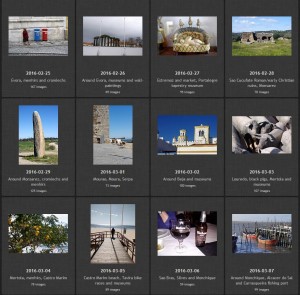
Entre-trois-pays: Letchworth, Entre-deux-Eaux and The Hague, May – July 2014
To download a printable PDF version (no pictures) click on this link E2E2014no2.pdf (five A4 pages)
At the beginning of May, as we prepared to leave Entre-deux-Eaux for Letchworth, we busied ourselves with sowing seeds and setting up the trickle-feed watering system. (Sadly the weather didn’t co-operate and we returned a month later to find the water tank empty and a total of two bean plants, two beetroot, shrivelled peas, a row of broad beans, a tub of marigolds and lots of weeds not to mention some very long grass in the meadow).
Having changed the car tyres from winter snow to summer, sorted out our French income and wealth tax submission and enjoyed an early birthday meal at the Frankenbourg, it was time to load up Bluto with items for the Letchworth house. This time they included my mother’s 1930s dark-stained oak bureau (which John had stripped and refinished to pale oak). And, given how much we had to take and how little space there was in Bluto (even though we had removed all except one of the rear passenger seats), into the bureau went sheets, towels, pillowcases and even a hover mower and its grass collector; round it went all the other essentials like pictures and posters, toys (including a large toy tractor and trailer), sewing machine and tools. On the roof rack a double-extending ladder and step ladder were strapped.
It was just as well that the ladders were firmly fixed as we set out on a very windy day and the ladders whistled and hummed as we drove across France. Feeling the need for a break, we had a brief pause for lunch at Reims IKEA (as a prelude to IKEAs across the channel). After a rougher than usual crossing the ferry was eased into Dover harbour by a tug, presumably to avoid damage to the berth. The sun shone on an idyllic Kentish countryside (so sad about the baby rabbit that darted out of the hedgerow), and the fish and chips at Broadstairs were good.
Next day we drove on to Billericay to see Ann and Derek, delayed only by John’s sudden urge to finish reading the Biggles story I was about to lend Ann, which was an exciting wartime yarn set in the area above Monte Carlo that we’d all enjoyed exploring a few weeks earlier. And then a reception committee of Toby and Jacob came up to welcome us back to our Letchworth house (once we’d unloaded).
IKEA on a wet Sunday in Milton Keynes was a bad idea, but with single-mindedness we managed to stock up on pillows, a second duvet, a selection of duvet covers and sheets as well as the by now very familiar Billy shelving units (oak – the selection of wood finishes in the UK is more limited than in France). Richer Sounds by the station was much quieter (as well as smaller) and we added a Panasonic TV, Humax Freesat box and Sony Blu-ray/DVD player to the day’s haul. Jacob enjoyed helping John to build the shelves on our return, not to mention making railway tracks, stations and bridges with all the cardboard packaging.
Cambridge, as my birthday treat, was much more agreeable, even if it too was wet and we did spend a lot of time in John Lewis looking at vacuum cleaners, dining tables and curtain fabric. John also bought me a birthday smart phone. On our return Jacob was bursting to sample the birthday cake before bedtime and present a large bouquet; and Stella had cooked a tasty bourguignon.
Over the next few days, Jacob began to expect a new box to unpack every day as Amazon books, a cool box and the vacuum cleaner were delivered. We also got a land line phone and broadband. Then we were ready for our first overnight visitor. The sun shone as Jessica drove up en route to our train-gang reunion in Norwich; she took one look at our garden, and got down on her hands and knees to weed steadily (the perfect guest!) as John erected a washing line “whirlygig” and Jacob fished in the pond and rode his tractor.
Norwich was hot and sunny, and, despite all the train delays experienced by the others, was a lovely place to stay. We caught up on each others’ lives, looked round old flint churches and the cathedral (everyone being resigned by now to my second-hand book forays, I was really pleased with the old children’s books I found) and we spent an enjoyable day at the Jacobean Blicking Hall. The unexpected highlight for us all was a sensational and imaginative Northern Ballet production of “A Midsummer Night’s Dream”, which kept as laughing and marvelling for the rest of our stay. Jessica and I also enjoyed Wymondham village and Grimes Graves during our drives to and from Norwich while the others struggled with delayed trains.
It has been so nice to find that Letchworth has been “on the way” for so many friends. Our next visitors were Ann and David, returning from Brighton. It was just a shame that the two sofas and the dining room table they’d hoped to help us unpack arrived after they had left (providing more good boxes for Jacob).
From the moment the legs were on the table, John made me and all subsequent visitors over the Bank Holiday weekend play the “can you spot the mark?” game. As no one else could see anything too bad, he eventually decided to accept the discount John Lewis had offered and to keep the table. I promptly covered it with curtain and lining fabric to make new dining room curtains.
The fine weather was an incentive to acquire garden furniture. It got a bit cool as we forced our next visitors, Roger and Dorinda, to have coffee outside, but it was perfect for sitting outside when Sue and Alistair stopped on their way between Cambridge and London. And we really know how to entertain our visitors, – the highlight of their visit was a trip to a large, cheap hardware emporium that John had just discovered. When Barbara and Bruce drove up from Winchester, we did not subject them to hardware, but they did have to listen to the sad tale of our cracked windscreen replacement: the previous day, in pouring rain, Autoglass had fitted the new front windscreen, and only when trying to fit the windscreen scuttle had they realised that windscreens for right-hand drive and left-hand drive Avensis Versos are mirror images!
Following Alistair’s pond inspection, our next shopping trip involved a drive down ever narrowing lanes, past village pubs and thatched cottages (one forgets that jigsaw puzzle England still exists) to a pond plant specialist. We wandered between greenhouses and outdoor tanks as the nice lady fished us out a selection of oxygenating plants and water snails. Jacob was summoned to help John plant the pond, as we wanted him to understand why he couldn’t “fish” in it any more.
And now that Jacob was familiar with house and garden, we had planned a last week of overnight stays for him (while Toby took Stella away for her birthday and then while Stella was away in London painting murals for children’s bedrooms). We started with a pre-birthday dinner for Stella and Toby; Jacob arrived in his red and white pyjamas, a large red cap, wellies and jewellery, which he considered an appropriate dinner party outfit. And so began a week of smaller concerns, like Little Kickers, pirate ships, biking round and round fountains, slides, making cakes with grandpa, animal stickers with Leila and that evergreen story, “Peepo”, punctuated with Hitchin Collectors’ Market with Leila and Stevenage hospital with Toby.
At the end of that week Leila returned with us to Entre-deux-Eaux and we spent a hot, pleasant and restful week at flea markets, playing games of Ticket to Ride (building train routes across Europe) and Yahtzee, watching World Cup games and lunching out at Parc Carola. We had last been to that restaurant at the end of the rather wet week of my 70th birthday celebrations; this time we sat outside, under the shade of the trees and parasols, with a view across to the roof-top Ribeauville swimming pool. On Leila’s last day, Entre-deux-Eaux and Anould laid on flea markets for her and we found more colourful Moroccan plates to hang in her small but lush back garden with all its yellow and blue pots and blue fence.
Despite Autoglass promises to get a correct windscreen fitted before we drove back it was left to Carglass, the Autoglass company in France, to finally fit the correct windscreen (now at a cost to our insurance of €750 rather than the original £350 quote – but they did give us a “free” set of windscreen wipers).
After that it was back to our everyday Entre-deux-Eaux preoccupations with weeding, mowing, sowing, football, slug pellets, and internet speed (our connection has been very variable this year, dropping from a usual 2Mb to slower than dial-up), interspersed with John making coffee tables and a TV unit for Letchworth, and my continuing the patchwork quilt. You won’t be surprised to read that there were a few restaurant trips as well. We went on one of our shopping expeditions over the Rhine and had lunch in a pretty wine village in the hills, Oberbergen. The restaurant was above a very modern wine producer, and we entered through the displays of wine bottles and up a staircase between the stainless steel fermenting vats and sat on a terrace overlooking the hills with incongruous but picturesque hens foraging and defecating below the tables. The end-of-term trip for the Entre-deux-Eaux oldies was to a restaurant with aspirations, the Julien, on the main road to Strasbourg. My first memory of that restaurant, when we took my mother for her 90th birthday, is of seeing a small white dog ensconced at the head of a table on a pile of cushions on a Louis XV chair. This time there were no dogs, just noisy pensioners. Afterwards we were graciously allowed to walk round the grounds, though not to use the hotel’s sauna, gym or swimming pools. The meal at another restaurant was much heartier (and tastier), a typically cruder Vosgian meal at the Auberge Habeaurupt in the valley that runs from Plainfaing to Gérardmer. It started with a huge salad, continued with a large plate of veal, included the (fast-vanishing from menus) traditional cheese course (local Munster and Brie) and concluded with a large pudding with lashings of cream and then coffee. Afterwards we stopped in Fraize to see a small historical exhibition on local industries (in fact just two, the Gantois woven mesh/perforated plate factory in Saint Dié and a glass-making village near Epinal). And for a bit more culture there was a book talk at the library and a talk on Saint Dié in August 1914 at the museum.
And then we began to feel restless and decided, very much on the spur of the moment, to take a short break. Some time ago we had watched with interest the BBC4 Andrew Graham-Dixon programme on the re-opening of the Amsterdam Rijksmuseum, and John had also noted the Mauritshuis in the Hague had only just re-opened. It must be about fifty years since I went to the art museums of Amsterdam and Rotterdam with Jessica, and the last of John’s conference trips to the Netherlands must have been at least twenty years ago.
We booked a room in a lovely boutique hotel in The Hague; it was an 1890s town house which a couple had lovingly modernised and decorated in restful shades of black, grey and cream. We had a very spacious stylish room with a balcony overlooking the quiet street and an en suite bathroom that was almost as large. Our host sorted out a parking permit and a tram/train/bus card (like a London Oyster card), and was happy to advise on restaurants and museums. The first evening we were pleased to find that Alan and Marianne (together with daughter Tessa) were back in nearby Delft, where Alan has been working. So we caught a tram to Delft, wandered round the lovely old town with its canals and market square, met up with them and Marianne’s parents and a colleague of Alan’s on the steps of the town hall and trooped off to track down that local delicacy, the first mussels of the season.
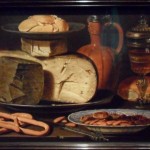
Clara Peeters: Still Life with Cheeses, Almonds and Pretzels – painted c1607–1621 (and frame shadow)
The next day, Tuesday, after a good breakfast, we caught a tram into town and walked through the Parliament buildings to the Mauritshuis Museum, a small palace with a delicate façade like a dolls’ house. It was a lovely setting for the smaller Dutch interiors and portraits (not to mention the famous Goldfinch and Girl with a Pearl Earring), and we enjoyed seeing some Rembrandts we hadn’t seen before (like the Two Moors) as well as some women artists like Clara Peeters, Judith Leyster and Rachel Ruysch (although rather disappointed in all the rooms by the deep shadows of the picture frames cast on some paintings by the otherwise praised natural colour LED lighting). After a stroll in the area round the museum and a coffee in the library (old habits), we decided to go to the very different Escher museum in the afternoon, which is housed in another former palace, although this one is now somewhat seedier. The earlier complex lithographs and woodcuts on the first two floors prior to his “impossible constructions” were equally fascinating, though younger visitors seemed more entranced by the puzzles, games and optical illusions on the third floor.
Returning along a narrow street of shops and restaurants between the tram stop and our hotel, we spotted some early Penguin novels in a box outside a second hand bookshop. Lured inside, we edged our way round what would be Jessica and Ellen’s worst nightmare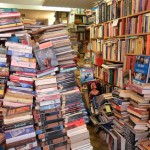 – precarious stacks of books on all subjects and in all languages; the shelves had some order to them, but were double- and triple-stacked too. Our tourist souvenirs that day consisted of two Penguins and two library shoulder bags (a bargain at 15 cents each). That evening we ate a rijsttafel at a small but packed Indonesian restaurant a few streets from out hotel.
– precarious stacks of books on all subjects and in all languages; the shelves had some order to them, but were double- and triple-stacked too. Our tourist souvenirs that day consisted of two Penguins and two library shoulder bags (a bargain at 15 cents each). That evening we ate a rijsttafel at a small but packed Indonesian restaurant a few streets from out hotel.
On the Wednesday we caught the train to Amsterdam (admiring the Art Nouveau station buildings at Haarlem as we passed through). Fortunately, despite all the gloomy predictions and the need to pre-book, we didn’t have to queue to get into the refurbished Rijksmuseum, and though the usual suspects like the Night Watch and the Vermeers attracted throngs, other rooms were quieter.
But for the sheer pleasure of examining exhibits in a spacious, airy, art deco (1935) building with no-one else in sight, the Gemeentemuseum back in The Hague the following morning won hands down.
We wandered through lavishly decorated Indonesian rooms, into Delft pottery, through Little Red Riding Hood, up to a fascinating exhibition of Mondrian and de Stijl (with furniture, paintings, videos and maquettes), into the café, on to their summer exhibition (inspired by the Royal Academy’s summer show) and finally the visually stunning Wonderkamers in the basement (though we didn’t borrow a tablet for the interactive displays). After such an intense experience we decided to take the tram to the sea at Scheveningen. But, instead of the fresh sea breezes over the dunes or fish stalls round the harbour, we found crowded beaches and cafés, and, after a very hot stroll along a promenade that could equally well been at Blackpool or Margate, were glad to rest our feet and recover with Italian ice cream.
In the evening we ate at an Italian restaurant that our fellow-guests had recommended. The antipasto platter alone would have made a meal, and when I ordered a limoncello at the end, a delicious slice of gateau was thrown in as well.
It was a mistake to take to the roads back to Entre-deux-Eaux on a July Friday as the traffic frequently came to a standstill with the combination of lorries, south-bound holiday traffic, road works and accidents at temperatures of 35 degrees. What a contrast with our drive north which had been through heavy rain, though when the rain eased, we had turned off the motorway and followed the River Moselle as far as Trier. Barbara and Bruce had been enthusiastic about their stay among the Roman remains there. We looked round the Porta Negra, the hideously baroque cathedral, the stark re-constructed Constantine’s basilica (now an austere protestant church) and then the rain descended in sheets and everyone ran for shelter. We eventually abandoned the rain-soaked amphitheatre and Roman baths and retreated to our pleasant hotel on the cliff above Trier.
We had an early dinner in the hotel and prepared to watch the Germany v. Argentina final. We had feared that a night in Germany after the match could be very noisy and we were pleasantly surprised that we were not disturbed that night. Outside a wine cellar we had been rather taken with a stone Roman wine ship as it captured the enjoyment of exploration we were feeling at the start of our short break.
Entre-deux-Eaux seemed very tranquil on our return. The weeds have of course grown in our short absence, the maize planted in the north field seems also to have shot up, and the blueberries in our fruit cage are abundant (so we can ignore the oddly Anglo-French sign in Saulcy to self-cueillette blueberries). A couple of days after our return we drove over the hills to Wolfisheim near Strasbourg and had a pleasant, leisurely lunch with Marie-Laure and Christian, who had previously shown some of us round Fort Kleber.
And now our thoughts are turning to Letchworth again. John has just booked our ferry and we are contemplating assorted piles of coffee tables, TV unit, cylinder mower, hedge trimmer, books, loudspeakers, fluorescent lights, TV (we brought the new one back to France), boxes of fabrics, tools, as well as wine, etc. and thinking about what will fit in the car this time – as we want to put in several rear seats. Do come and see us there if you are around during August, – especially as we now have a dining table and some sofas!
Tarmac and Trams and Tulips: January – April 2013 in Entre-deux- Eaux, Lisbon and Porto
To download a printable PDF version (no pictures) click on this link
E2E2013no1.pdf (five A4 pages)
There is a complete set of labelled photographs (950+) showing many more of the museums, galleries, street scenes, graffiti, etc. we saw during the Portugal trip. They are on eight web pages starting at https://blackmores-online.info/Portugal/index.html
Can you hear the rumble of a lorry coming up rue du Mont Davaux? No? False alarm. Just the EDF man in his blue van to read the meters. The only other activity outside is the steady chewing of the cows in one field, the galloping of two excitable horses in another, a pair of buzzards circling overhead and a flash of brown, possibly a hare, on the north field.
We have been getting slovenly over the protracted wet weeks of winter, often reading (books or computer screen) in bed till quite a late hour in the mornings. But today we were up and dressed soon after 7 o’clock, as French workmen can arrive at 8 o’clock to get in a solid chunk of work before the two-hour lunch break. We were looking forward to the latest (though it never turns out to be the last) of the outdoor house restoration projects. However it’s 10 o’clock and no Monsieur Pasquier and his tarmacing team. So now to relax, have a coffee and catch up on newsletters, the last one being a pre-Christmas one.
There was a chance that this newsletter could have come to you from India. However, after Christmas at Leila’s in Nottingham, we spent a longer than usual time in London (thank you again Jessica and Mark!). It was great to catch up with family and friends, especially seeing more of Jacob as he approached his second birthday. And then the hot season on the east coast of India was approaching too fast to get organised with injections, visas, etc. and still enjoy cooler weather throughout our travels. So our third Indian adventure is postponed till autumn.
Instead, we spent ten days at the end of February and start of March in Portugal. We arrived in Lisbon (by plane from Basel) and took the metro. With warnings about pickpockets circulating, I clutched my belongings possessively, but we emerged unscathed into a square at the foot of one of Lisbon’s steep hills. Our hotel was near the castle, which, like all castles, was on top of the hill, and we had just missed the clanking number 12 tram. The taxi at the head of the queue in the square was a decrepit Mercedes, long ago exhausted by the hills, and whenever it was brought to a halt in the steep, dark, narrow cobbled streets, we were uncertain whether it would lurch into rattling action once more. The light spilling out from the hotel’s glass door was very welcome, as was the news that they’d upgraded us to an enormous room, complete with sofa, armchairs, low table, writing desk, vast bed and a large terrace (the perfect room for relaxing in between sorties). Had we caught the tram, I doubt we’d have found the right stop to get off, let alone the hotel, in the dark, unlabelled streets.
As so often, it was the unexpected things that were entrancing. On our first morning we paused at what looked like a bank to ask for directions, and the woman insisted on our exploring her building which had recently been converted into a design and fashion museum with fascinating exhibits.
MUDE had indeed once been a bank (Banco Nacional Ultramarino) before being gutted, apart from the bank director’s wooden-panelled room and some mosaic murals, then left unused. Another day we’d reached the old water pumping station and museum, hot and sticky after a boring walk by the railway line, and the small static equipment and photograph exhibition was rather dull. Then, as we pushed open a door, we were engulfed by the most wonderful sounds of early choral music. In the middle of the aromatic, highly polished (floors and brass) pumping station machine room a small choir was rehearsing. The acoustics were excellent as we scrambled up the wrought iron staircases and walkways above the choir and now-retired pumps. And to further revive us, the tile museum a bit further along the railway line was in a rambling convent with an unexpectedly good café.
Another unexpected treat was the Ethnology Museum, now mainly just an archive, which recently had enough funding to display one room of exhibits; Mali puppets leered out of the darkness as individual showcases lit up at our approach. And a very informative young researcher conducted two fascinating store-room tours of Portugal’s everyday rural life implements and Amazonian artefacts.
The trams were as much fun as we expected, and we enjoyed exploiting our three-day tourist ticket to the full by riding several to the end of their lines (although, for pensioners it is doubtful if the combined museum entrance/tram ticket is cheaper than the other museum discounts available). We also stopped at the enormous tram depot, where we had some difficulty in locating the small tram museum and rousing the staff; eventually they mustered one lady to sell tickets, one man to open the door at the far end to usher us and the solitary other visitor into a waiting tram, one man to drive said tram (a beautifully re-upholstered and curtained vehicle) to some far sheds, one man to open the small shop, and one man to man the small gallery. The tram driver sat and twiddled his thumbs till be were ready to be returned to the exit. As well as the trams themselves, it was interesting to see the safety posters, the tramway corporation’s brass band exhibits and the in-house ticket printing equipment.
Our tourist ticket also entitled us to take the train out to Sintra. The railway station from which we left Lisbon was a stunning mixture of elaborate Manueline exterior, modern escalators and glass, and platform walls tiled with what looked like scenes from literary fantasies. Sintra’s railway station was more modest, unlike its palaces, over-priced tourist restaurants and cafés, and Moorish castle remains. But we enjoyed wonderful views from the Moorish walls and spotted an interesting-looking neo-gothic mansion, chapel and gardens.
Our map identified it as the Quinta da Regaleira, and on impulse we decided to find it. The terraced grounds contained the neo-gothic essentials of ferns, winding paths, follies, statuary, noisy waterfall and dank grottoes. Inside, amid hunting scenes, a pianist was rehearsing thunderously and his cascades resounded up the staircase, into the small library with its unnerving floating floor and out onto the ramparts with their gargoyles and sculpted snails. Again an unanticipated pleasure.
In Porto where, alas, our room was less lavish but the breakfasts superb, it was rainy, so we sheltered one afternoon in one of the lesser-known (to us, at least) port wine producers, Calem, near the more famous black silhouette of Sandeman; the tour and tasting was rather fun. We also took the metro about 30km to very nearly the end of the line and a small fishing village, Vila do Conde, with its dramatic aqueduct and narrow streets.
Porto also has my idea of the perfect-looking small bookshop, recently restored to neo-gothic splendour, a dairy serving great éclairs, and tall, decaying buildings, art-nouveau, tiled, and much in need of money and loving attention.
We were tourists, in cities, and at popular tourists sites, so were not seeing the dire economic situation of Portugal most of the time. And whilst there were very few people eating in the small fish restaurants on top of our hill in Lisbon, the café bars were busy with locals eating pastries and drinking coffees at all hours. However, one afternoon the trams came to a halt some distance from the main squares for the huge “Fuck the Troika” march, with protesters of all ages, classes and political beliefs united in protest against the austerity measures imposed by the IMF, EU and Central European Bank. We watched it file noisily past for some time, unable to pass through it, and sensing no end to the throng, retired to a café to put a few euros into the economy.
Before we went to Portugal we had indulged in the usual round of winter activities in and around Entre-deux-Eaux. At the mayor (and commune’s) lunch for the old folk, the food was good as ever and the wine flowed as freely as ever. The main course was described as “parmentier de canard, fondant, au beurre de Normandie, gratine, pousses de mesclun, copeaux de parmesan et tomates confites”, or, as John more succinctly translated, duck shepherd’s pie with salad. For the first time an accordionist from the village provided the music and banter, whilst the dancing between courses was as stylish as ever. The mayor sat quite near us and we realised that his lady friend is one of the delightful sisters who run the nearby La Soyotte farm museum. Later the same week the E2E monthly club for oldies had its AGM followed by lunch, – this time couscous, cooked by the retired fireman’s wife who’d gone to a lot of trouble on the desserts, making ice bowls with leaves and petals prettily encased between two layers of ice to hold the orange slices and ice cream. It was a real delight when Marcel was persuaded to go and get his accordion. He was the kindly shopkeeper back in the 1990s when we first bought our house, and has gone through a bad time since his wife died a few years ago. So it was really lovely to hear him play –he’d once recounted to us how he used to play when he was young at weddings and in their family café. Apparently he was also mayor some time before our present long-standing mayor. John sloped off after the lunch as the packs of cards and the Scrabble board came out. I always say that Scrabble-playing improves my French, though the idiosyncratic spelling of the charming and vivacious wife of one of the former Big Four Farmers doesn’t really help. We had no dictionary, so shrill appeals were made to the mayor who had once been a teacher. But, after a few glasses of wine, as her protests became shriller, it was easier to give her a free hand with spelling.
There was also the AGM of the Philomatique (which is not some tin-pot local history group, but self-styled “savants” with a good publication programme). It concluded with an interesting documentary film about St Dié at the end of the war. And, of course, there was the annual trip over the hills to the village of Saulxures, where a group of local actors feed their audience (with a kir aperitif, wine and coffee included, to get everyone in a good humour) before their performance. This year’s farce was set in an ecologically friendly house in the Vosges so had local references and some Vosgian dialect, which were much appreciated. One of the main characters was played by a local baker, who, apparently, does very good bread on other days!
One event we had not been aware of in previous years was an antiques fair in St Dié, this time held in the old police building. One dealer caught me returning to gaze at a couple of drawings, which were in fact limited lithographs of pencil drawings. He told us that the artist was Abel Pann, who worked in Paris from 1903-1913. He then went to Jerusalem, intending to settle there, but on his return to Paris to collect his things, was prevented by the first world war. He finally moved there in 1920. “My” drawings were part of a series of forty seven illustrations of the first five books of the Bible, done in 1930. Pann later did holocaust pictures and our salesman claimed he is usually bought by Parisian Jews with whom the exodus story resonates. A complete set of forty seven would command huge prices, but he would accept 200 euros for his two. Attractive as they were, we left them for any visiting Parisians to snap up.
On a more mundane note, John sampled the opticians as he had snapped the bridge of his glasses over Christmas, and his fetching epoxy resin glue repairs had not lasted.I still had a few remaining sessions with the St Dié orthoptist, prescribed by the Strasbourg ophthalmologist for eye exercises after I got my new glasses from the Ste Marguerite dispensing optician. These sessions were agreeably childish, looking from the red car to the red mushroom, or following the elephant on the stick! The highlight was when I had an exercise with a screen rabbit (like Peter Rabbit) loosing his tail and his bunch of flowers. It was clearly a treat as it wasn’t repeated. The subsequent screen fish tank and the kites were not as whimsical. We have not had nearly as much snow as the UK, but I did have to clear the garage exit several mornings before these appointments.
The snow was more of a problem on the day that ERDF (the company that owns the electricity infrastructure) were due to make the final connection for the photovoltaic panels. On arrival the man announced that he would be unable to test whether they were working with snow on the roof covering the panels, so made a second appointment to connect. That second morning he rang to confirm there was no snow. All was well. Then an hour before his arrival, the snow started to fall, covering the panels rapidly. John went out with a hose trying to wash the snow from the roof, and later got the ladders out on the snowy terrace to brush the bottom sections of the roof clear. Cold and slippery work, especially when some snow landed on his eye and went down the gap at the top of his anorak. The man said the roads were slippery too as it was new snow. Fortunately he was able to get enough minimal output to be able to check the connections and meters, but it definitely wasn’t the best of weathers for starting to produce solar energy!
We have, however had a few balmy days since our return from Portugal. One of those days we spent wandering round Colmar, seeing it with fresh eyes as we followed a tourist trail devoid of other tourists. We did, however, run into a couple we’d sat with at one of the E2E post-Christmas lunches but did not know well; although we recognised their faces, it took some time to really realise who they were. They were amazed to find two other villagers in the Bartholdi Museum courtyard! And another morning in Ribeauvillé was equally pleasant (again without many tourists despite the spring sunshine).
In a more recent outbreak of dry weather, John was able to get the potager rotavated and I dug in compost and started sowing vegetable seeds. Then the sun came out as Mark and Jessica arrived en route to Putney from Sienna (where they too had had cold and wet weather) so shared our enjoyment of the cowslips covering the orchard, and the windflowers, daffodils and first butterflies. After they left the following morning, we joined the Ste Marguerite group for a walk at the Col de Ste Marie. It was very pretty as it went down from the ridge through woods and fields, then slowly up through the woods to the Tree of Liberty, passing German bunkers, shelters, workshops, traces of the funicular, a mortar launching pit and an intriguing sign to a swimming pool (possibly to aid recovery, including from gas attacks, probably for officers), all from the first world war. However, Lucien, the leader for that day, who is a cyclist not historian, pursued his walk relentlessly, so no exploring. Somewhere to return to with a torch one day. It was the perfect day for a walk.
In the latest precious trio of sunny days, the damson and plum
blossom frothed up, and we spotted more fritillaries in our meadow than we’ve ever seen before – silently colonising amid the more noticeable ladies smock. And so far two bold scarlet tulips and six fiery orange ones have survived the rodent winter feasting in the flower garden. A colourful small spring triumph.
But now the rain has set in again, the tulips look forlorn and the tarmac team have definitely not arrived. We hold our breath.
———————————————————————
Time out from Entre-deux-Eaux: Portugal, volcanoes, piri-piri and football
To download a printable Adobe Acrobat version click on this link E2EYr8Weeks41-5.pdf (seven A4 pages)
Clicking on a photo will take you to a larger single image.
Clicking on one of the underlined links (e.g. food) will take you to a selection of photos.
Everyone has their own tale of volcanic ash and the disruption of travel plans. Ours began with a cookery book, Piri piri starfish: Portugal found, which Leila had given John. His bedtime reading of these recipes led to the idea of travelling to Portugal to sample authentic dishes for ourselves. Combine this with our love of train-travel and you can imagine the sequence: book a cheap Ryanair flight in April/early May from Baden-Baden to Porto, then a leisurely train journey round northern Portugal, sampling the wines and food. We would start by travelling up the Douro valley, with its spectacular scenery and branch off on the dramatic narrow-gauge railways up the Douro tributaries…
The plan was doomed from the start. First of all, research into train timetables showed that the narrow-gauge railways had got too dramatic, with fatal accidents, and were currently closed for essential work. And then of course, Iceland suffered a volcano crisis and flights began to be cancelled. We wondered whether we should postpone the trip (but then we’d miss the spring flowers) or drive down (a long journey, but the car would enable us to see more remote areas).
Late that Saturday afternoon, with planes still grounded, John returned with Bluto and a clean bill of health from the car’s obligatory controle technique (MOT equivalent), and we decided to cancel our Porto hotels, forget the train timetables, throw a few clothes in the back of the car, and start driving the following morning. Of course, although we included John’s computer and recent guide books to Portugal, we hadn’t updated our road maps for this trip, so we had a 2004 Michelin road atlas of France, a 2000 road atlas of Europe and our faithful (but already with out-of-date maps) satnav, Gladys. (At a service station we hastily purchased a Michelin map of Portugal). So we were soon struck by how new motorways have opened up swathes of rural France for rapid travel, in a way that the railways must once have done. Once out of Lorraine, we found ourselves careering through boar and deer forests towards Orleans on a motorway that wasn’t even a dotted line on our map book. The other shock was that the days of comfortable family hotels in every small French town seem to have vanished without us noticing, and we were reduced to finding a cheap hotel chain on some industrial estate near the airport on the outskirts of Poitiers (but at least there were no planes overhead).
The following day saw us crossing the border into Spain, between Bayonne and Bilbao, feeling as if the days of the highwaymen demanding every last coin had not vanished, as tolls were exacted every few kilometres. And then we lunged off down another splendid new motorway to Vitoria, with tunnels, soaring bridges, fantastic rock striations and stunning views.
On our third day, we decided it was time to slow down and appreciate a little of north-west Spain before crossing into Portugal, so we spent a morning in Salamanca, enjoying the old cathedral, elegant churches the huge Plaza Major with its outdoor cafés and young musicians in black doublets and hose. Then we drove on to the small hill-top walled town of Ciudad Rodrigo, on the Spanish side of the border. Our room in the Palacio Maldonado (lavishly refurbished downstairs and pleasant upstairs) overlooked the ramparts, a favoured route of dog-walkers, it seemed. But in place of cannons and attacking soldiers, sheep grazed peacefully between the defensive walls, and small black donkeys by the river. The fourteenth century castle, accustomed to withstanding the Moors, the Portuguese and Napoleon, had also lapsed into a more peaceful role as a Parador, and we decided to experience their “taste of the region” menu. By 10 o’clock, when we were ready for bed, the Spanish were just settling down to their food.
We crossed the border into Portugal the next morning. On the original plan, we’d have been in Porto, on the coast. This route felt like the back door into Portugal, – the scruffy route. The well-tended land on the Spanish side changed abruptly to wilderness. Once there had been fields with walls, and there must have been homes. But now it was abandoned. And then we reached the first hill-top fortifications on the Portuguese side – Almeida in its familiar Vauban star-shaped glory. Two vans with hunting horns painted on their sides hurtled through the gates to deliver the post to outlying areas.
It was a surprise, once we had walked through the impressive tunnelled gateways, to find that the village inside had the air of a Cornish fishing village, with its whitewashed walls and narrow streets. It had undergone a face-lift since the military finally left in 1928. I was particularly touched, as you can imagine, when I paused in front of the library, and was pushed enthusiastically inside by a passing inhabitant, who clearly thought it was one of the marvels of the town. It had been attractively renovated. It didn’t seem to have many books (though an old one was open in a showcase at an illustration of the fort at Agra) but the computers were all in use and chairs were being organised for a meeting or lecture. Down by the old barracks, the fire station was making its own preparations, with firemen busily washing their engines. The subterranean barracks had been turned into a museum with displays of different military periods. The pictures illustrating the Peninsular War all looked like stills from “Sharpe’s Gold”. However, listening to the commentary, it soon became obvious that Wellington’s victories against the French were due not to the fictional Sharpe and his small band, but to the outstanding Portuguese soldiers who Wellington always placed in the front of any attack. At lunch time, the small bar where we were still having coffee (after our leisurely breakfast discussing volcanic ash and alternative land and sea routes with an enterprising English couple) was popular with workmen who were served earthenware bowls of steaming food.
From Almeida we drove towards Foz Coa, enjoying the whites, purples and lavenders of the wild flowers as well as the vines, almonds, olives and freshly ploughed fields. We stopped in Castelo Melhor, and joined four congenial English people (who’d also had to make alternative travel plans) and a guide bouncing down a rutted track in an Archaeological Park landrover to some of the prehistoric rock carvings by the river. These are not in caves (like Lascaux) or under dramatic overhangs (as in the Drakensberg Mountains) but on separate bits of schist rock face, shorn off in places.
And, if they had been painted, there is no trace of paint now, just layers of overlaid scraped or chiselled lines. The guide was very good, tracing in the air all the lines we could so easily have overlooked. We examined six rocks out of the hundreds that have been found. They were noticed when a dam was being built, and all work on the dam has come to a halt since. We spent the night in a grumpy hotel in Foz Coa, dashing out in the torrential rain to the nearest restaurant. No sign of chicken piri-piri or hearty casseroles there, so John had good cod and fried potato and I had veal escalopes and chips, both accompanied by a rice and bean mix and a very heady wine.
With rain still threatening next morning we visited more prehistoric rock carvings by the river Coa at Canada Inferno, then headed towards the Douro. We were seduced by mention of ruins to detour along a cobbled narrow track between stone walls, which followed a contour and vineyards round the hillsides for several kilometres. Again the wild flowers were so pretty in the afternoon sunshine, and everything was fresh after last night’s rain. There were no houses and no people apart from some French walkers along this ancient-feeling route.
And then, below us we spotted ruined columns and walls. It was a spectacular site, in need of some explanatory panels, but appeared to be Roman, built on Neolithic remains.
As we dropped down from the mountains towards the River Douro, we were engulfed by more vine terraces, and could have drunk our way westwards at any of the great port names, (including Sandeman in his black cape). John had found on the internet a remote agrotourism hotel up in the hills for the night. It was so remote that it was hard to find (Gladys was a star here), and it was great to be welcomed on our arrival with a glass of port and the news that, as it was quiet, we’d been upgraded from a double room to our own stone cottage, with sitting room and small garden. As you can imagine, we can thoroughly recommend this new venture, with its enthusiastic young manager. Apparently his mother does all the cooking, but we never saw her enter or emerge from the kitchen. After a walk through orchards and vineyards and a bath, Mama’s locally-sourced food was served: starters of either succulent black sausage or bread sausage, followed by cod in corn bread or pork in a sweet and sour sauce, and a white wine from the days when it had been a farm. On the TV in the main sitting room Fulham was playing Hamburg, and we sank into the sofas to watch.
Next morning Mamma’s home-made pumpkin jam was delicious on the freshly delivered rolls, not to mention her chocolate cake. We headed off to Lamego for the day, but it was another diversion that proved the most enjoyable – to the Visigothic / Romanesque chapel of São Pedro de Balsemão (the oldest church in Portugal, we discovered later). We weren’t even sure that we’d found it at first, as from the side it looked a bit like a run-down factory with four-square stone walls. Rounding a corner we could see stone steps and a doorway with coats of arms. We were still uncertain, but once up the steps we were stunned to find ourselves in a small basilica with three naves, columns with Corinthian capitals, a coffered, painted, wooden seventeenth century ceiling, and a beautiful fourteenth century bishop’s tomb resting on recumbent lions.
A cheerful lady came bustling in from the courtyard on the other side, wiping her hands on an apron and pointing out all the “primitive” features and the fourteenth century Virgin of the O, the pregnant Virgin Mary. There were also fragments of Roman epigraphs incorporated into the walls, to add to the timeless feels of the little church. But then, alas, time intervened, for she was clearly anxious to serve the lunch she’d been preparing. So we drove on to Lamego and its castle, museum, churches and drab ladies’ and gents’ outfitters. But it was Balsamão that had captivated us. That evening Mama offered a choice between baked octopus and veal followed by strawberries or “pudding” (like a slice of thick crème caramel)
Having really enjoyed two nights of agrotourism, we decided to book another rural hotel, on the other side of the Douro, handy for Braga, the mediaeval town of Guimaraes and the fortified Celtic hill settlement of Breiteros. This hotel was even harder to find with just a name and place, but it seemed to be well known for miles around, as burly workmen in cafés drew us diagrams of how to get back on course and find it (road, town and street signs in rural Portugal are nearly non-existent and both Google maps and Gladys had identified only one place of the same name in the area, which turned out to be the wrong one). From the moment we reached its high walls and gate, we felt there was some mystery about it, which was perhaps well known to the locals. The man who greeted us had the air of a pirate, as he escorted us down the steps from the gate into a well-tended garden of fountains, box hedged paths, vine-covered terrace, red roses, azaleas, rhododendrons, pure white lilies, stone tables and white chairs.
Then his father appeared, and our pirate started to shuffle deferentially. Father struck John as a fallen aristo (and me as a wily lawyer). The odd duo showed us our cottage, which initially felt a bit damp, and then the main house with the sombre dining room for breakfast next morning. Clearly, promoting local foods is not part of their role, for no dinner was provided, and the nearest town of Fafe on a Sunday night was uninspiring. Over breakfast the next morning, father and son hovered in a menacing fashion, watching our every mouthful. It transpired that mother lives in Porto (in two houses), but father acquired this quinta twenty years ago, in some dodgy sounding deal where a friend first purchased but couldn’t afford it.
Father was determined that we should see a pilgrim church on a hill with a baroque staircase with fountains, but we were more keen to see the Celtic Citania de Briteiros. This is an amazing archaeological site. We’ve never seen such a vast hill settlement before, nor walls which rise two to three feet high. John suspected the nineteenth century archaeologists of rebuilding many of the walls, when we saw other areas which looked like undifferentiated rubble. We spent a long time there in the heat of the mid-day sun, and also enjoyed the small museum in the village, then drove on to Braga behind a car whose hobbit-sized owner had imbibed excessively. We strolled round Braga, rather overwhelmed by the exuberant jungle of carvings on the cathedral’s organ and the gilded balcony choir stalls. Appropriately, we dined at the Churrasqueira da Se (Cathedral Grill) on nibbles of fishcakes, olives and sausage slices, followed by salad, grilled meat and mounds of rice and chips (chicken piri piri is still proving elusive). The patron on his barstool was transfixed by the match between Braga and Naval (so we added to our scant knowledge of the Portuguese football league), but he leapt off his stool, yelling as Braga scored the first goal.
Next morning, Father was anxious to be handed cash for the two nights’ “hospitality” before he left for Porto, and we were escorted from the gated premises by the pirate. We decided against trying to drive and park in Porto, but crossed back over the Douro outside Porto, stopped for coffee in the coastal town of Aveiro, with its art deco houses and colourful high-prowed boats, then headed south-east towards a night of extravagant pleasures at the Buçaco Palace Hotel (I’d pleaded an imminent birthday when John had expressed doubts). Like so many beautiful things, the walled forest in which the palace is situated, was created by monks. They planted hundreds of species of trees round their convent, as a reminder of Mount Carmel and a symbol of earthly paradise.
The flat, dull countryside vanished as we plunged into this lush, hilly forest, with its follies, towers and neglected chapels (along a mossy Via Crucis). We were enclosed in another world – magical, contemplative, inviting. Beneath the soaring trees were streams with decadent white lilies, winding paths, steps, cascades, formal box-edged gardens, and a wisteria walk dripping mauve flowers. And then, plonked in the middle, next to the monks old chapel, was the neo-Manueline, icing-sugar, fantasy palace created at the end of the nineteenth and beginning of the twentieth century. It had the air of a maharaja’s palace, and indeed, some of the blue and white tile pictures inside depicted the Portuguese ruler of India, along with scenes from the battle of Buçaco in 1810 (in which Wellington’s army defeated the French after the Siege of Ciudad Rodrigo, the Battle of Coa, and the Siege of Almeida – had we unwittingly been following the French attack route?). The forest outside was romanticised inside in huge wall paintings of minstrels, ladies, and hunters in the smoking room-cum-bar, whilst the hallway was a riot of carved white Edinburgh rock.
That evening, after a forest walk and a lingering bath, we descended to a dining room which combined features of a large railway station buffet with those of a French château. Amid the array of starched linen, wine glasses and painted walls (sailing ships in misty seas), we ordered a splendid-sounding dinner. But with the wine list starting at 1,000 euro for a bottle red and 800 euro for white (as well as 3,600 euro for vintage port) and stopping at 40 euro, John pointedly ordered beer while I splashed out on an eight euro glass of indifferent white wine. With no chicken on the menu, my companion, as they say in reviews, chose a starter of suckling pig ravioli, giblets sauce and orange zest confit, followed it with a very fiddly-to-eat steamed ray wing with raspberry emulsion, bread pudding with tomato and green asparagus, and still had an appetite for grilled wild boar with garlic and rosemary sautéed potato with cider and rapini purée tartlet (though found the boar dry). I really enjoyed my more delicate suckling pig salad with pistachios, pine nuts and marinated figs in Douro Moscatel followed by gratinated scallop and sautéed tiger prawn with pennyroyal leek confit. When the dessert trolley rattled up, we both chose the tropical fruit tart and a slab of ice-cream with walnut, vanilla and red fruit.
Not surprisingly we slept heartily and woke to an equally sumptuous breakfast laid out on the central oval table. I couldn’t bring myself to start the day with chilled “champagne” or with a cooked breakfast, but loved the three-tiered fruit bowl in the centre and the candelabra of bowls of cereals, apricots and fruit salad and the ceramic hen on its boiled eggs. After we’d explored more of the dappled forest, we drove out of the enchanted forest and back onto the scrubby plain, and the Roman marvels at Conimbriga. It was a hot day, and the noisy school groups were as bothersome as flies. But we really enjoyed the ruins, with their spectacular mosaic floors.
But it wasn’t until one of the school groups put some money in a slot we had overlooked, that we got the full benefit of Roman engineering, as reconstructed fountains (or jets of water) all round the central garden of irises, began to spray water. Such a cooling sound. The underground heating of the baths was also impressive, though we weren’t so keen on the partial reconstruction of the forum. Behind the house of the fountains rose a later, enormous, defensive wall which cut right through the rows of Roman houses, but, alas, it had failed to keep out the barbarians. The museum was good and informative and its café was great for plum juice, peach juice and the most delicious sweet pastries.
From Roman Conimbriga we moved on to Portugal’s former Moorish stronghold and mediaeval capital Coimbra (and the incongruously named Hotel Oslo). As the day began to cool, we climbed up a great many steps from the Moorish gateway, past linen and ceramic shops, towards the old cathedral and the university at the top (and not until we reached the top did we spot the yellow trams on their alternative route). However the cool blue-and-white café part way up served some of the best (and cheapest) coffee and (on the way down) beer. The old Romanesque cathedral was lovely (we never made it to the new cathedral) and we lingered there before continuing up to the glories of the university’s 18th century Joanina Library (I had to get another library in).
This reminded me of academic libraries I had worked in, with its galleries and step ladders. But nothing in my past matched the splendours (and gilding) of this Baroque library. And I had certainly never worked in a library where the bats were encouraged at night (after the tables had been covered over) to feed on any papyrophagus insects which might threaten the ancient volumes.
Back at the foot of the hill, we dined in a small family-run restaurant in a narrow street. The old man cooked, his wife kept popping out and returning with plastic bags, and a daughter waited cheerfully and briskly on a mix of students, locals and tourists. We were glad of the bread and salty sheep’s cheese as we waited for our goat in red wine to cook. Here a carafe of good house red wine cost four euro (a bit of a contrast with the previous night’s prices).
If you’ve read so far, you’ll have shared some of our impressions of Portugal’s Palaeolithic, Roman, Celtic, Visigothic, Moorish, Romanesque, Manueline, Napoleonic and neo-Manueline cultures. As our journey neared its end we wanted to spend the next day seeing something of the Knights Templar and the Jewish community at Tomar. Tomar’s small restored mediaeval synagogue was in an small house at the foot of the hill which had been used as a prison, a barn and a warehouse after the Jews were forced in 1496 to convert or flee Portugal. Now there are not enough Jewish men for a Torah service to be held (the quorum being ten), and it has become a museum. Round the wall are moving letters and cultural gifts from Jewish visitors from around the world.
By contrast, the Knights Templar Convento de Cristo up on the hill is an enormous, rambling statement of power. This monastic fortress with its crenellated walls to repel the Moors, dominates the town. The vows of poverty of the Knights Templar were not much in evidence as we wandered from one magnificent cloister to another and into the opulently decorated round church and ambulatory (did the KTs really ride their horses there?), the choir (its stalls missing after the Napoleonic troops woz ‘ere), and out again to look at facades dripping with sculpted symbols of maritime power. The T-shaped dormitory corridors at the far end were long, dark and sinister-feeling, with the arching aqueduct outside. After that I began to lose all sense of direction as we followed lower corridors, through the refectory, kitchens (which smelt of recent smoke), stables, a store-room for olive oil and firewood and another containing unlabelled mosaics and a sundial. Children’s screams and laughter could be heard at one point and people emerged from private doorways and disappeared up corridors. An ideally mysterious setting for the occasional five hour performances (with five meal breaks) of Umberto Eco’s “The Name of the Rose.” We spent that night in Constancia, and ate in a blue-tiled tapas bar (veal for me and cod for John, so little change there) watching Inter Milan versus Barcelona. The bar customers seem happy that the Italian team, no doubt due to the leadership of their José Mourinho, beat the Spanish.
Next day we saw more castles, including Almourol on its island, complete with ferryman, before reaching the border town of Castelo de Vide. There we wandered through the attractive old town, with its fountain, flowers and cats. Both the synagogue and castle were closed, by then, but maybe we’d seen enough castles for the day. So we sloped off for a beer in the late afternoon sunshine. To our surprise chicken was on the bar’s menu of the day. What better place for our last dinner in Portugal? When we returned later for soup, chicken in beer (it came, as usual, with chips and rice) and chocolate mousse, a baby was the focus of the tiny room, being passed noisily round the staff so that its harassed parents could tackle their splendid-looking skewers of prawns and chicken. Above, on the small screen, Liverpool were losing in extra time to Atletico Madrid. Our hotel that night was a former girls’ school, fully-booked by cyclists and their supporters for the following night (the next town was hosting a big cycle race). Internet comments had mentioned cramped bathrooms, so we shouldn’t have been surprised that it proved impossible to sit on the loo other than side-saddle (to avoid the sides of the small bath and large bidet-thing).
We visited the Friday market (clothes, hardware and cowbells outside, local produce inside) before leaving next day, then set out for home. We stayed in Ciudad Rodrigo again (same room even), looked round Zamora’s cathedral and castle, had a night in the Holiday Inn outside Vitoria, then decided to take a different route back through France. We had both been thinking nostalgically of our honeymoon camping trip round central France. It was a mistake to think we could recapture the old magic. The Puy de Dome looked great from a distance (and at least there was no volcanic ash), but somebody had moved all the streets of our favourite village from how we remembered them and its magical Café du Centre was closed. Tournus cathedral was somehow less atmospheric and we couldn’t find a decent coffee. And the little hilltop village of Brancion, with a Romanesque church, had been “restored” into a medieval theme park whilst the church’s amazing frescoes had been allowed to deteriorate. Then Bluto got a puncture and we couldn’t get the wheel off to put on the spare and I ended up with diarrhoea. So much for nostalgia. However, we had thoroughly enjoyed our first impressions of northern Portugal. We just need to remember – we’ll never be able to return to Portugal and have the same experiences again (although we might find chicken piri-piri).
(And, in case you hadn’t realised, the food link at the top takes you to the photos of our meals)
Photographs
Zamora
Castel de Vide
Tomar
JoaninaLibrary, Coimbra
Conimbriga Roman ruins
Buçaco Palace Hotel (neo-Manueline)
Bussaco Forest near Coimbra (panorama)
Citania de Briteiros (iron age)
São Pedro de Balsemão Visigothic chapel
Rock carvings of the Foz Coa valley
Almeida
Salamanca
Cathedral Vieja (Old Cathedral), Salamanca (panorama)
Ciudad Rodrigo (Spain)
St Philibert Romanesque Church, Tournus, France (panorama)
The Great Train Journey – the last week (Erzurum – Istanbul – Vienna – Entre-deux-Eaux) and an answer to all your questions
To download a printable Adobe Acrobat version click on this link The_Great_Train_Journey-week4.pdf (four A4 pages)
Clicking on any of the small photographs will open a larger version in another window
Did we get back safely from our 10,000km Great Train Journey, you ask? Yes, thank-you. Our Inter-rail pass lasted 30 days, and on the evening of the 30th day our taxi from Saint Dié station was duly approaching our shuttered-up house. The grass had grown lush and tall since our departure, and the house and garden looked like they used to in their early days as a holiday-only retreat. And oddly there were no cows.
Were our dreams fulfilled? In terms of a rail journey across Europe and east to Lake Van, as follow-up to our long-ago rail journeys round India, it was every bit as much fun, though perhaps less elegant than I’d hoped. 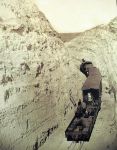 We were in Erzurum when we last wrote. And as we waited at Erzurum railway station for the delayed train back to Istanbul, there was an exhibition of large sepia photos of the building of the railway line from Istanbul to Medina (never quite reaching the goal of Mecca), which gave an impression of earlier Ottoman and German dreams of grandeur and empire. T E Lawrence (of Arabia) was also there looking heroic and menacing, as was a film-still of a wrecked train. Sadly, the glamour of rail travel is in danger of vanishing along with the steam engines. Most of the Romanian and Turkish rolling stock was shabby and grubby and dining cars were only occasionally present. However, the new high-speed trains should restore some of the glamour and excitement. We travelled alongside the completed section of the Ankara to Istanbul high-speed track. And later during the return journey, some of the new Austrian and German trains restored the excitement and comfort of rail travel.
We were in Erzurum when we last wrote. And as we waited at Erzurum railway station for the delayed train back to Istanbul, there was an exhibition of large sepia photos of the building of the railway line from Istanbul to Medina (never quite reaching the goal of Mecca), which gave an impression of earlier Ottoman and German dreams of grandeur and empire. T E Lawrence (of Arabia) was also there looking heroic and menacing, as was a film-still of a wrecked train. Sadly, the glamour of rail travel is in danger of vanishing along with the steam engines. Most of the Romanian and Turkish rolling stock was shabby and grubby and dining cars were only occasionally present. However, the new high-speed trains should restore some of the glamour and excitement. We travelled alongside the completed section of the Ankara to Istanbul high-speed track. And later during the return journey, some of the new Austrian and German trains restored the excitement and comfort of rail travel.
The buffet car of the Railjet between Vienna and Munich, with its curving blue seats and pink walls was almost as seductive as those long-ago glimpses of the Golden Arrow dining cars. And in Vienna itself, where we spent a whole morning riding the trams (with the excuse of a 24 hour ticket and John’s injured ankles), we spotted a double decker “weasel” train, so changed onto that and I fulfilled another dream of travelling upstairs on a train. (It was from there that we had a view every bit as dramatic as that in The Third Man, of the famous Ferris wheel).
Another dream had been to sense the fabulous Byzantium/ Constantinople lurking beneath modern Istanbul. We’d been fired up by the Royal Academy’s Byzantium exhibition back in January. But it was hard to piece together a picture of the old city. The archaeological museum is magnificent, but even that did not provide an overall picture. It feels as if over a thousand years of Byzantine history have little relevance to Turkey. The city walls, first spotted from the train, were striking reminders of the size of Constantinople. But unfortunately the building of the same railway line had destroyed some of the ruins of the old Bucoleon Palace by the sea (and former harbour). 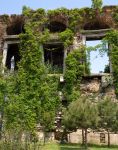 When we were first in Istanbul, we enjoyed the restored Byzantine churches we’d seen. On our return from eastern Turkey it was good to have more time in Istanbul, to look for further remains of the old Byzantium. Our guide book warned that ruins of the Bucoleon Palace are now the haunt of tramps, and indeed, as we approached, one gentleman was spreading out his washing to dry on the old stone palace walls.
When we were first in Istanbul, we enjoyed the restored Byzantine churches we’d seen. On our return from eastern Turkey it was good to have more time in Istanbul, to look for further remains of the old Byzantium. Our guide book warned that ruins of the Bucoleon Palace are now the haunt of tramps, and indeed, as we approached, one gentleman was spreading out his washing to dry on the old stone palace walls.
As we were finding our way round the modern city, three obelisks and columns kept looming up in unexpected places, making us realise that we weren’t quite where we thought we were, but were back on the site of the old hippodrome. It got quite comical in the end. But somehow, with all the big white tourist coaches waiting outside the nearby Blue Mosque, and the throngs being guided round the obelisks, it was hard to get a sense of the old hippodrome (though it would have been equally packed). But as we walked back from the remains of the old palace walls, our eyes sharpened, we  came across a huge curved wall above a street market, which must have been the semi-circular turn of the old race course. Another fragment of former grandeur. And of course the uncovered mosaics in the remaining Byzantine churches were glorious, especially with the glowing golds. Maybe one day the depressingly unloved Hagia Sophia will also be restored to glory.
came across a huge curved wall above a street market, which must have been the semi-circular turn of the old race course. Another fragment of former grandeur. And of course the uncovered mosaics in the remaining Byzantine churches were glorious, especially with the glowing golds. Maybe one day the depressingly unloved Hagia Sophia will also be restored to glory.
And there were unexpected pleasures in Istanbul. It took a while to work out the ferry boats with all their different quays, but they were a picturesque and cool way of getting around. Returning from the east in the very late evening, it was great to come out of the railway station, step onto a ferry, and realise that the skyline was this time a familiar one in which we could almost pick out our hotel in the streets below Hagia Sophia. We later spent a day going up the Bosphorus and back. Wandering the narrow streets between our hotel and the sea front Bucoleon Palace was another pleasure, with the old wooden (former merchants’) houses jutting out over the streets. 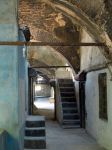 And the scale of the old caravanserais between the Grand Bazaar and the Spice Bazaar was stunning. Most of them are very ramshackle now. Dark crumbling staircases lead up to rooms off the cool, arcaded corridors. Through open doorways men can faintly be seen in the gloom, machining trousers and raincoats or hammering away at silver dinner services or trophies. It was easy to imagine all kinds of dramatic film chases through these arcades, or sinister murder stories.
And the scale of the old caravanserais between the Grand Bazaar and the Spice Bazaar was stunning. Most of them are very ramshackle now. Dark crumbling staircases lead up to rooms off the cool, arcaded corridors. Through open doorways men can faintly be seen in the gloom, machining trousers and raincoats or hammering away at silver dinner services or trophies. It was easy to imagine all kinds of dramatic film chases through these arcades, or sinister murder stories.
And did I get my special birthday meal on the train from Erzurum to Istanbul? The sleeping car promised well as we got on the train, for it was the most modern so far, a soothing pale grey colour, and even equipped with a small fridge. And for the first time the attendant presented us with some sustenance, – sour cherry juice, biscuits and chocolate. The scenery that evening was spectacular as we left behind the snow capped mountains, following the Euphrates through gorges, plunging into tunnels (there must have been over 150), and even having the sky briefly radiant with a double rainbow arching behind us above the gorge tunnels. The journey of a couple of our travelling companions made ours seem quite tame, as they were en route from Japan to Austria. But sadly the omelette and chips or kebap and rice, washed down with Nescafe in the dining car did not feel over-festive. So after spending our first day back in Istanbul at the Topkapi Palace and its harem, we dined in style on a roof-top restaurant overlooking 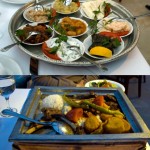 the Sea of Marmara on one side and the Blue Mosque on the other. The tray of traditional starters were all delicious, the Sultan’s taste (lamb cooked in five different ways) arrive in an elaborate lidded copper dish, along with a salad. The desert was a succulent selection but the crowning glory was the home-made cherry liqueur which was so delicious that we commented on it, so more was immediately brought. That definitely beat omelette, chips and Nescafe!
the Sea of Marmara on one side and the Blue Mosque on the other. The tray of traditional starters were all delicious, the Sultan’s taste (lamb cooked in five different ways) arrive in an elaborate lidded copper dish, along with a salad. The desert was a succulent selection but the crowning glory was the home-made cherry liqueur which was so delicious that we commented on it, so more was immediately brought. That definitely beat omelette, chips and Nescafe!
In general, 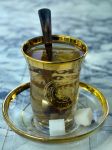 we found it surprisingly hard to find good restaurant food, especially at reasonable prices, and in the Sultanahmet area where we stayed. However occasional dishes like vine leaves stuffed with cherries or lamb and sour plum casserole were a wonderful exception to the ubiquitous kebaps and pideci (pizzas). And we did relish stopping for an apple tea and baklava in the afternoon heat. Not to mention the large rooftop breakfasts which provided a great start to the day.
we found it surprisingly hard to find good restaurant food, especially at reasonable prices, and in the Sultanahmet area where we stayed. However occasional dishes like vine leaves stuffed with cherries or lamb and sour plum casserole were a wonderful exception to the ubiquitous kebaps and pideci (pizzas). And we did relish stopping for an apple tea and baklava in the afternoon heat. Not to mention the large rooftop breakfasts which provided a great start to the day.
How about a birthday present with a difference? Well, a large rug would have been tempting. But we must be loosing our stamina for the hassle of bargaining and the patter of men trying to lure you into their unique emporium. You could fritter away a lifetime with carpet salesmen and cups of tea. And we never spotted the perfect rug (and never saw any being sold). The other temptation was a tile. 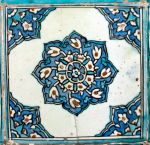 Yes, just a single tile. We’d seen such wonderful tiles in the mosques and fountains and the Topkapi Palace, that it would have been fun to incorporate one of the Iznik tiles into our bathroom back in Entre-deux-Eaux. But with such ridiculous starting prices as 100 euro, it was hardly worthwhile to open the bargaining. So I shall content myself with ordering some more Orhan Pamuk novels, and try out Barbara Nadel’s Istanbul crime stories.
Yes, just a single tile. We’d seen such wonderful tiles in the mosques and fountains and the Topkapi Palace, that it would have been fun to incorporate one of the Iznik tiles into our bathroom back in Entre-deux-Eaux. But with such ridiculous starting prices as 100 euro, it was hardly worthwhile to open the bargaining. So I shall content myself with ordering some more Orhan Pamuk novels, and try out Barbara Nadel’s Istanbul crime stories.
So had we enjoyed Istanbul despite the bazaar hustlers and the partial neglect of the Byzantine heritage? We really had. It was a great time (especially on our return when it was quieter than our stay a few weeks earlier when much of Europe seemed to be visiting during the public holidays) and we were sad to leave on the night train. Appropriately our parting views from the train were of the old city walls, and the illuminated Byzantine harbour excavations (discovered when tunnelling for the new metro).
We’d chosen the return route via Bucharest, Budapest and Vienna, rather that the more usual Belgrade and Sofia (Orient Express) route, as we’d heard there were often long delays in Bulgaria that way (and indeed we later heard that the Austrian couple we’d met earlier ran into delays and missed their connections on that line). Vienna would have been sacrificed had we too gone that way.
Meanwhile, had John bought new shoes in Istanbul? And what about the Sultan’s Revenge? Well, our medicine chests of diarrhoea remedies remained untouched, which was good. But the lack of footwear was (literally) John’s downfall. He’d already slipped on a wet ramp in Romania and rain-soaked cobbles in Istanbul despite the grip of his walking boots (so his wrist had been bandaged ever since). The temperature had shot up since we left Erzurum, so John was now wearing the battered sandals he’d packed at the last minute (after reading travellers tales of filthy showers and toilets). Having arrived safely at Vienna Westbahnhof, John realised he’d left his glasses on the train, so ran back to retrieve them. Maybe it was the sandals, maybe it was the forty hours of inactivity on the trains from Istanbul, maybe the lack of salt after the heat of Istanbul, but both his Achilles tendons gave way. And his glasses had gone.
We stayed in a curiously old fashioned pension in Vienna, with a huge brass bed, huge wardrobes, huge dining room table (and correspondingly huge breakfast) and a landlady with a walking stick and a resigned dog. She seemed most perturbed that John did not leave our room that first day, apart from hobbling to the restaurant over the road in the evening, which was a Hong Kong Cookhouse. (I’d in the meantime got over-baroqued by all the city’s white and gold buildings). There were no other customers at the Cookhouse, but the young woman was harassed, and frenzied shouts came from the kitchen as delivery men appeared and disappeared with freezer boxes. The next day we embarked on our tram trip from the end of our road, culminating at St Stephen’s cathedral in the centre, with an open air café, a large coffee and cake (traditional Sachertorte for John). More trams and we got out at the Upper Belvedere, to see the Klimts. But even better was the temporary exhibition in the Lower Belvedere of Alphonse Mucha. And that evening John limped down to the nearest pub/stub where we had a more typically Austrian meal – and beer. Despite John’s injury, I’m glad we didn’t miss out on Vienna.
Day 30 and our last day on the trains. Eleven hours of trains, starting with the elegant Austrian Railjet (with its buffet-car) from Vienna to Salzburg and Munich, then an inter-city from Munich to Karlsruhe. The regional express from Karlsruhe was more packed than we could have imagined at 4 p.m. on a Wednesday, even allowing for schoolchildren. But the next day was Ascension Day and, given the hot weather, everyone seemed to be taking their bicycles into the Black Forest for the weekend. Our carriage somehow fitted at least 8 bicycles and panniers in between other people’s knees and luggage – and several had to be taken off and put back on at each halt so other passengers could alight. On our penultimate train (a regional all-stations) from Appenweier to Strasbourg, the German commuters got off at Kehl at the border and the French got on, and it was surprisingly exhilarating to hear French again. Safely over the Rhine, we caught the last of our trains, from Strasbourg to St Dié. Alas, taxis no longer bother to meet the trains at Saint Dié on the off-chance of trade, so we stood forlornly, before ringing for a taxi.
And the cows, which mysteriously weren’t grazing in the Entre-deux-Eaux fields? The shock news when we collected our post from Mme Laine, is that Dominique Duhaut has sold them all! He and Olivier have not managed to work harmoniously together (perhaps no surprise) and are dissolving the partnership at the end of the year. For now the cows have been sold and the fields lie uncut. It sounds as if two brothers from Taintrux and other farmers from Corcieux may between them take over the land.
And since then, our doctor has said that Achilles tendon injuries take a long time to mend, so John, like Farmer Duhaut, is taking life easily. Perhaps a different form of the sultan’s revenge so near the end of a wonderful journey?
The Great Train Journey – First week’s travels
copy of an e-mail sent 27 April 2009
To download a printable Adobe Acrobat version click on this link The_Great_Train_Journey-week1.pdf (two A4 pages)
There are now photographs of the Romanian Painted Monasteries we visited
Our travels have been good so far. Dorinda and Roger started us off in style with a lift to St Die, where we took trains to Stasbourg then Offenburg. The German trains were all very punctual, so all our first day’s 10 minute connections worked smoothly, via Munich and Vienna. The Hungarian express was very new and swish, and felt the right way to travel internationally. From Budapest to Romania was not so stylish, and our sleep in the station waiting room just over the Romanian border was fitful. The second morning our 1st class upgrade on the Romanian train northwards was the shabbiest we’d been on, with smelly loos with only occasional water. It was a dreary start through the drab, uncultivated plains north of Arad with seedy concrete blocks of flats even in the middle of the countryside, rusting old gas pipes and derelict industries. Later the landscape in Transylvania was pretty, with its mountains and small plots of land still being ploughed with the aid of horses. It seemed to be the day for sowing potatoes, just before St George’s Day (maybe he protects potatoes as well as beautiful princesses).
We spent 3 mainly sunny spring-like days in the north of Romania, based in Suceava, within travelling distance of the painted monasteries of Bucovina. The paintings are all over the outside as well as the inside walls – all the Bible stories and lives of gruesomely martyred saints, many we’ve never heard of, were there in wonderful colour and we had a very enthusiastic guide, who loved the monasteries and their paintings (though I think she was a bit disappointed that we weren’t in the league of Michael Palin who she also showed round for his New European programme). And St.George’s day was being celebrated at the first, Voronet (no dragon, though, just a special service with the Archbishop of Suceava). We had Romanian food one night and another day we had lunch at one of the monasteries (excellent blueberry aperitif!).
Then, it was up for the 5 a.m. train to Bucharest, and the last leg of the journey on to Istanbul. Alas the fake Orient Express was way beyond our means, but the serviceable old Romanian sleeper we were on, which kept getting hooked onto other trains in Bulgaria, was a great night’s sleep, apart from the obligatory stop and descent at the Turkish border around 3 a.m. to obtain visas and police stamps.
We arrived in Istanbul reasonably on time, the train running between the sea and the old city walls for much of the time – very picturesque. The stylish old Orient Express restaurant on the platform alas didn’t stoop to morning coffee, with its tables all set with damask cloths and wine glasses beneath the portrait of Agatha Christie and film stars. But we found a great patisserie cum Turkish Delight shop a short distance from the station and treated ourselves to coffee and pastries in its blue tiled splendour to build up our strength before cramming into a tram (almost as bad as Indian transport – but no one on the roof) and then lugging our cases along cobbled streets to the Hotel Alp, (in the Sultanahmet area below the Hagia Sofia mosque and the Topkapi palace), perched on the edge of a rock face overlooking the port in the distance. Then the rain started.
We had various practical things to check in the afternoon, but after doing those, our footsteps almost inevitably led to the huge covered grand bazaar, with its carpets, lamps, antiques, fabrics, leather goods, ceramics etc. Great fun. And there’s still the spice bazaar to try another day. We hadn’t meant to buy anything, but we were forced to linger over the men’s shoes as John’s feet were feeling very wet and he realised the sole of one of his only pair of shoes had split right across, and the rain was getting harder. What timing! However the slim pointy turquoise or silver patent contemporary styles didn’t appeal to him! We saw one or two more sensible shoes on the way back here, but had had enough by then. Off shortly to look for food.
More later.
Saint-Dié: The only factory designed and built to plans by Le Corbusier
In November 1944 the whole of the centre of Saint-Dié was dynamited and burnt to the ground by the retreating German troops; over 2000 buildings were destroyed. Any remaining walls and shells of building were demolished by the council. In 1945 Le Corbusier was appointed architect to redevelop both public and private buildings of the town. He put forward a radical plan which involved separation of roads and pedestrian areas; much of the accommodation for residents was to be in tower blocks (Machines à habiter). But the project was too revolutionary for both the town council and population (who would have had to give up their rights to the land they owned and individual properties) and was rejected in early 1946 in favour of a more traditional plan based on the old town centre layout. Le plan de reconstruction de Saint-Dié (1945)
Eventually the only industrial building ever completed by Le Corbusier, the Usine de Bonneterie Claude et Duval, was built in Saint-Dié during 1948-51. In July 2009 the factory was included in the UNESCO World Heritage list. Today it is still in use as a factory but the building is decaying probably due to poor post-war building materials and lack of maintenance.
If you click on Le Corbusier: Usine de Bonneterie Claude et Duval, Saint-Dié for the panorama
………………………………………………


